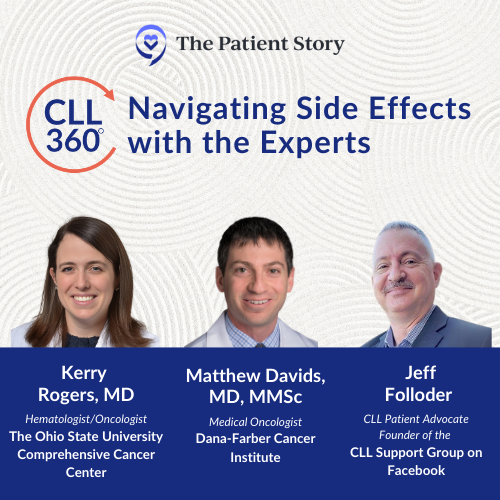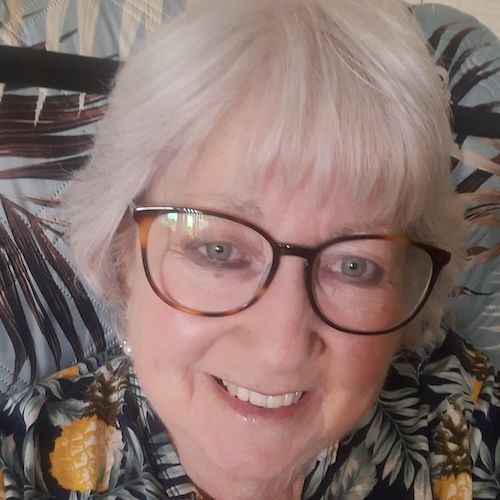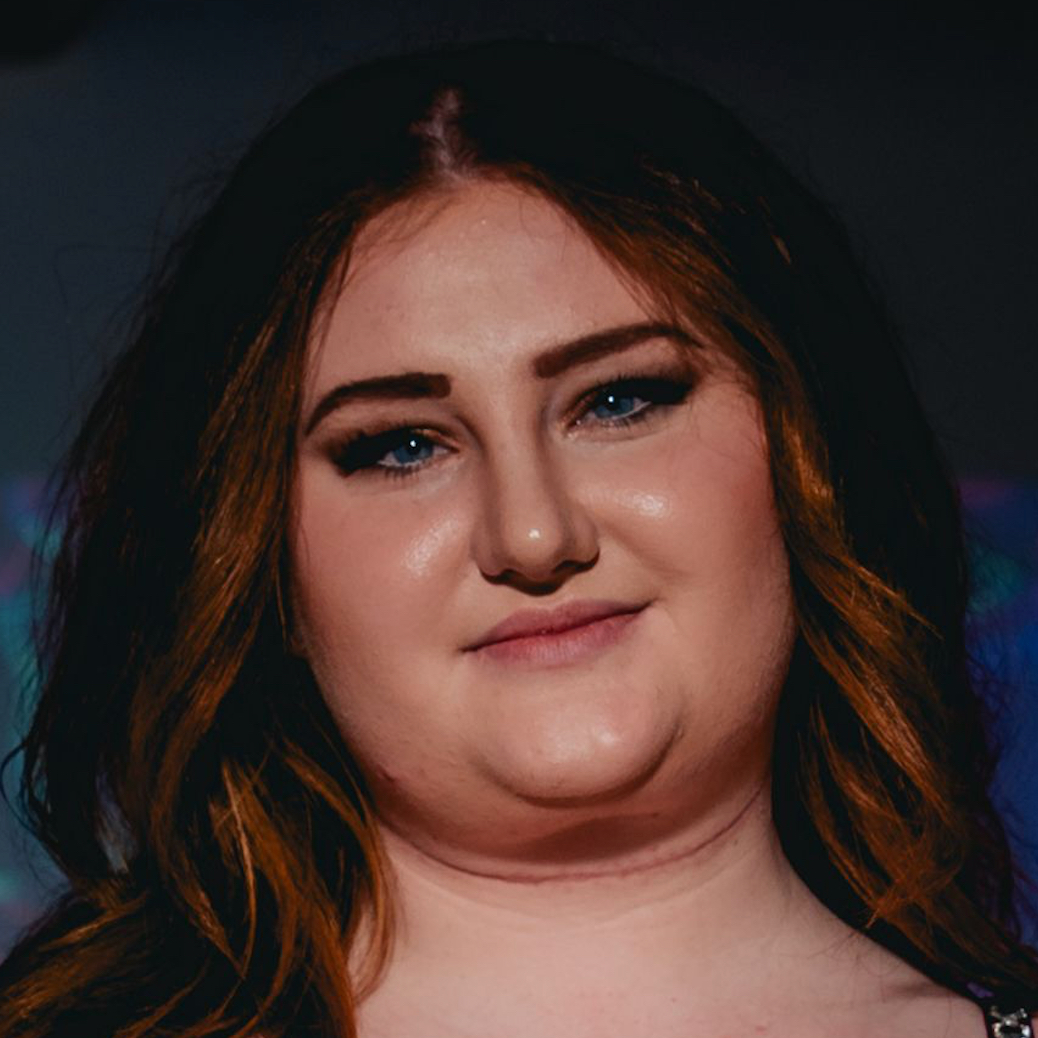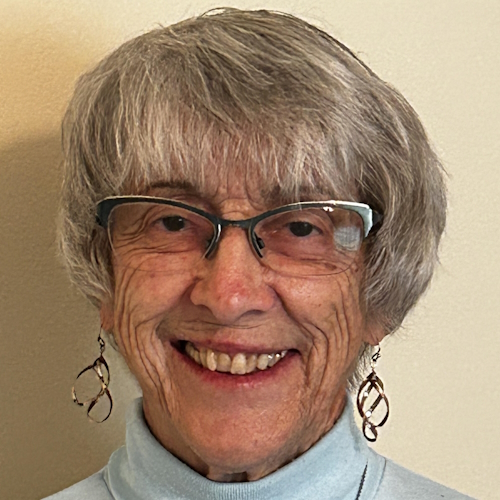CLL 360°: Navigating Side Effects with the Experts
Edited by: Katrina Villareal
Hosted by CLL patient advocate Jeff Folloder, this crucial discussion on chronic lymphocytic leukemia (CLL) with Dr. Matthew Davids from the Dana-Farber Cancer Institute and Dr. Kerry Rogers from The Ohio State University Comprehensive Cancer Center will equip you with the knowledge to manage CLL treatment side effects better and improve communication with your healthcare team.
Understand the latest advancements in CLL therapy and their impact on patients. Gain practical advice on managing the side effects of CLL treatments, including BTK inhibitors. Learn how to balance treatment efficacy with tolerability to improve your daily life. Discover ways to communicate your concerns and treatment preferences with your healthcare providers.

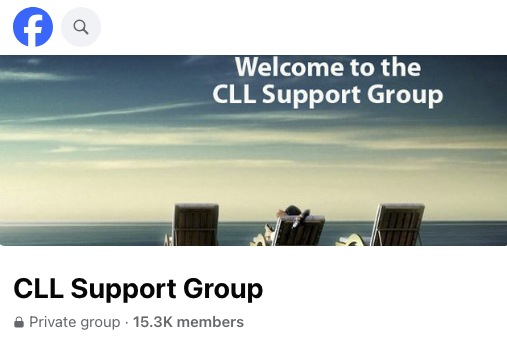
We would like to thank The Leukemia & Lymphoma Society and The CLL Support Group for their partnerships.
This interview has been edited for clarity and length. This is not medical advice. Please consult with your healthcare provider for treatment decisions.
- Introduction
- Impact of Recent Treatment Advancements on Side Effects
- Relationship Between Side Effects and Quality of Life for CLL Patients
- Treatment Side Effects vs. Treatment Schedule
- Dealing with Side Effects
- How Can Patients Actively Participate in Their Care?
- Effective Patient-Physician Communication
- Overcoming the Fear of Dose Reduction
- Fostering Effective Provider Communication
- Clinical Trials in CLL
- Shared Decision-Making in Your Care
- Final Takeaways
- Conclusion
Introduction
Stephanie Chuang, The Patient Story Founder
Stephanie Chuang: As part of our CLL 360° series, this topic is navigating side effects with the experts, both on the patient side as well as the medical side. The goal is for you to walk away with a better understanding of what side effects are commonly driven by CLL treatments and how to help manage them, including how to have conversations with your medical team about them.
This program is hosted by The Patient Story. Our multi-platform organization aims to help people navigate life before and after diagnosis through in-depth patient stories and educational discussions, which we understand is especially important for a community like CLL where you’re all so engaged and want to empower yourselves continuously.
The Patient Story was born out of my experience as a blood cancer patient in non-Hodgkin lymphoma. I remember feeling very alone and that access to humanized information was hard. Hopefully, this is something to help fill that void.
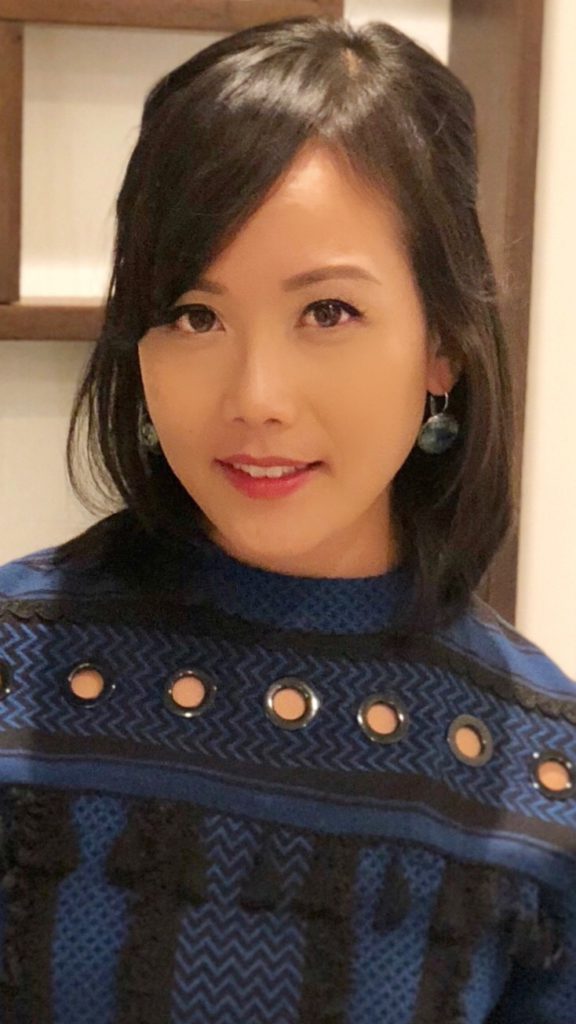
We want to thank The Leukemia & Lymphoma Society for its partnership. The LLS offers incredible free resources, like their Information Specialists who provide one-on-one support in different areas for blood cancer. We also want to thank The CLL Support Group on Facebook led by our friends, including our moderator Jeff Folloder. They provide virtual support anytime for folks dealing with a CLL diagnosis.
We want to thank our sponsors for their support, which helps us to host more of these programs for free to our audience. The Patient Story retains full editorial control over all the content. While we hope this will be very helpful and that you walk away with a better understanding of this topic, this is not meant to be a substitute for your own medical advice.
Now we get to the great discussion ahead and I’ll send it to Jeff.
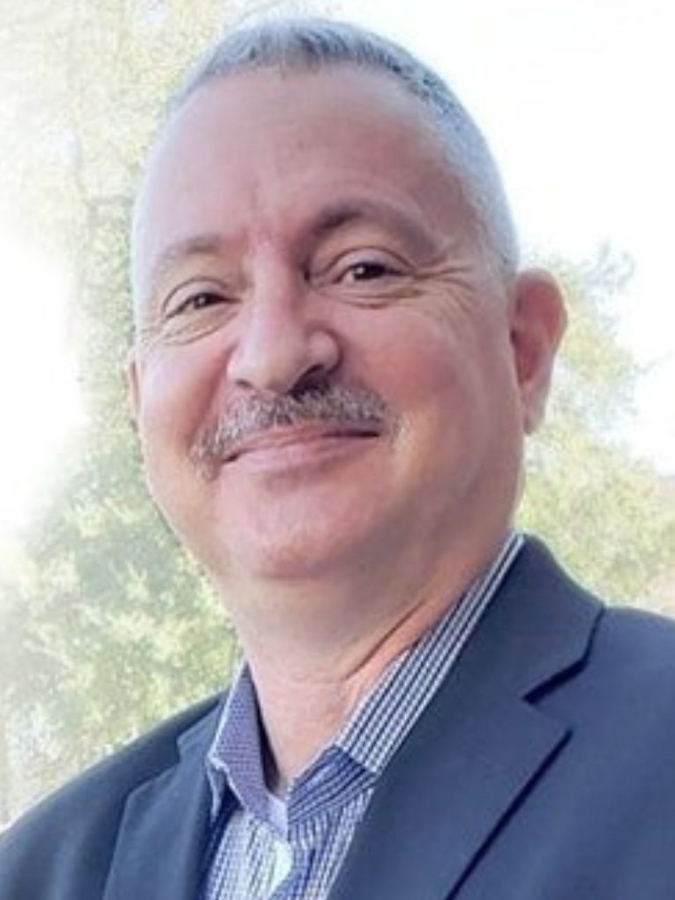
Jeff Folloder, CLL Patient Advocate
Jeff Folloder: I am a passionate patient care advocate. Why am I an advocate? Because I know that it is truly possible to live a great life with a CLL diagnosis.
I went through a clinical trial many years ago. I experienced side effects, which were quite profound. I know so much has changed. There are still side effects, but we take care of them differently.
We have two fantastic medical experts to join us. Dr. Matthew Davids is an associate professor of medicine at the Division of Lymphoma of the Harvard Medical School. He’s a hematologist-oncologist at the Dana-Farber Cancer Institute where he serves as director of clinical research and associate director of the Center for Chronic Lymphocytic Leukemia. Dr. Davids, why CLL?
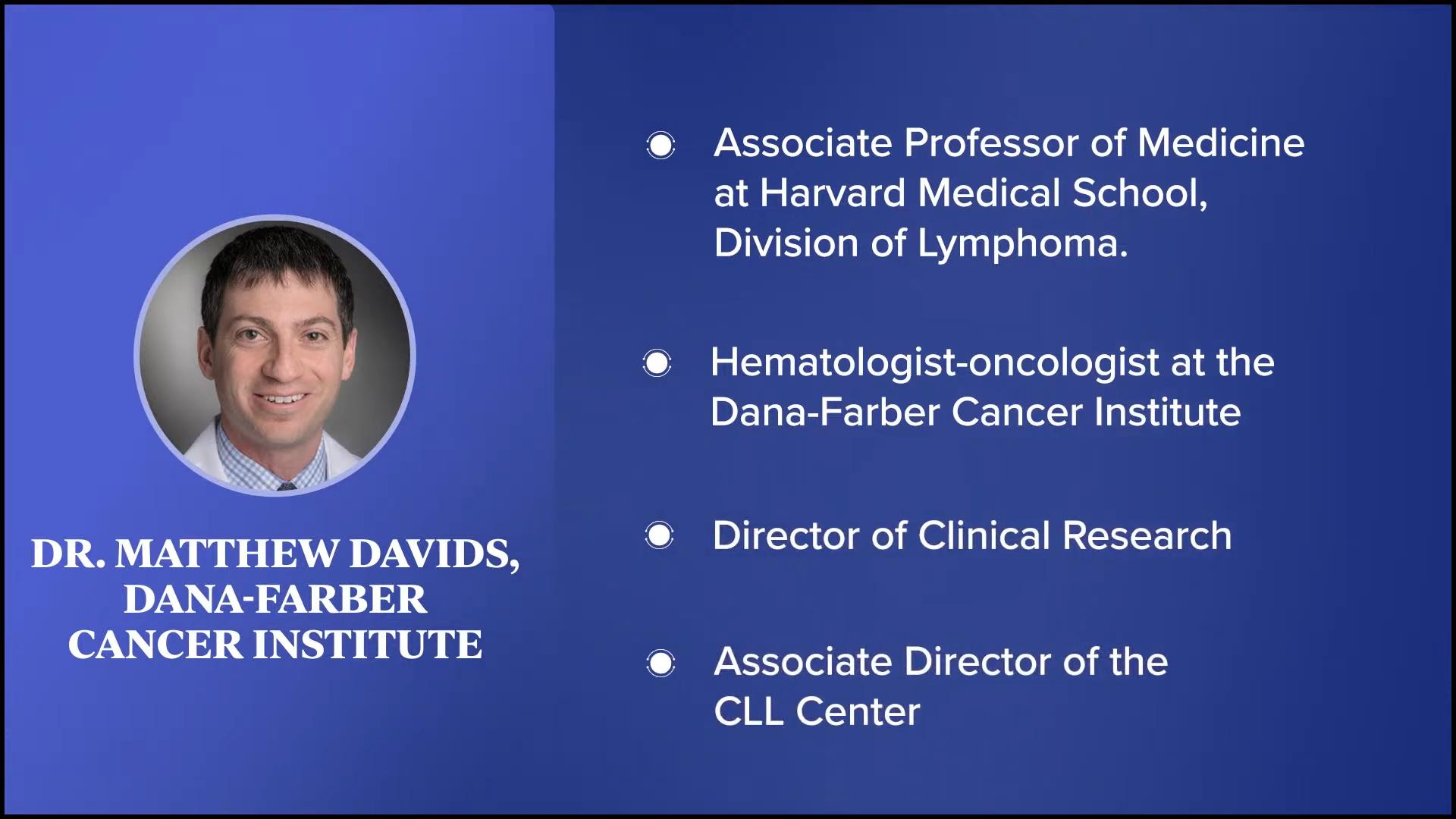
Dr. Matthew Davids, Hematologist-Oncologist
Dr. Matthew Davids: I was very fortunate to grow up in the era when we were starting to transition away from chemotherapy to targeted therapies. We could begin to develop drugs with fewer side effects and more effective than chemotherapy. I was inspired by that and the relationships with my patients, and I haven’t looked back.
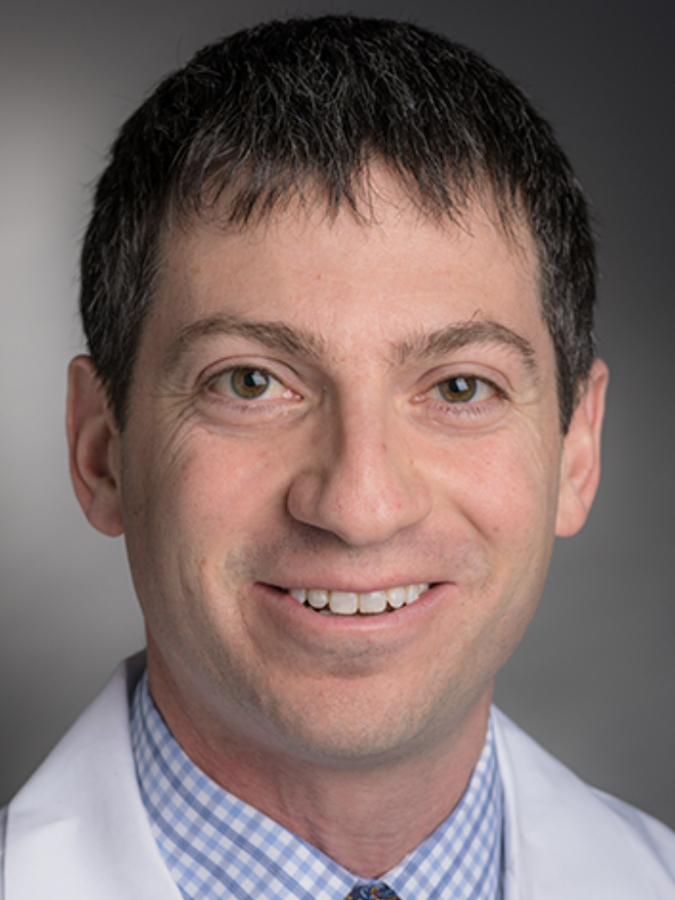
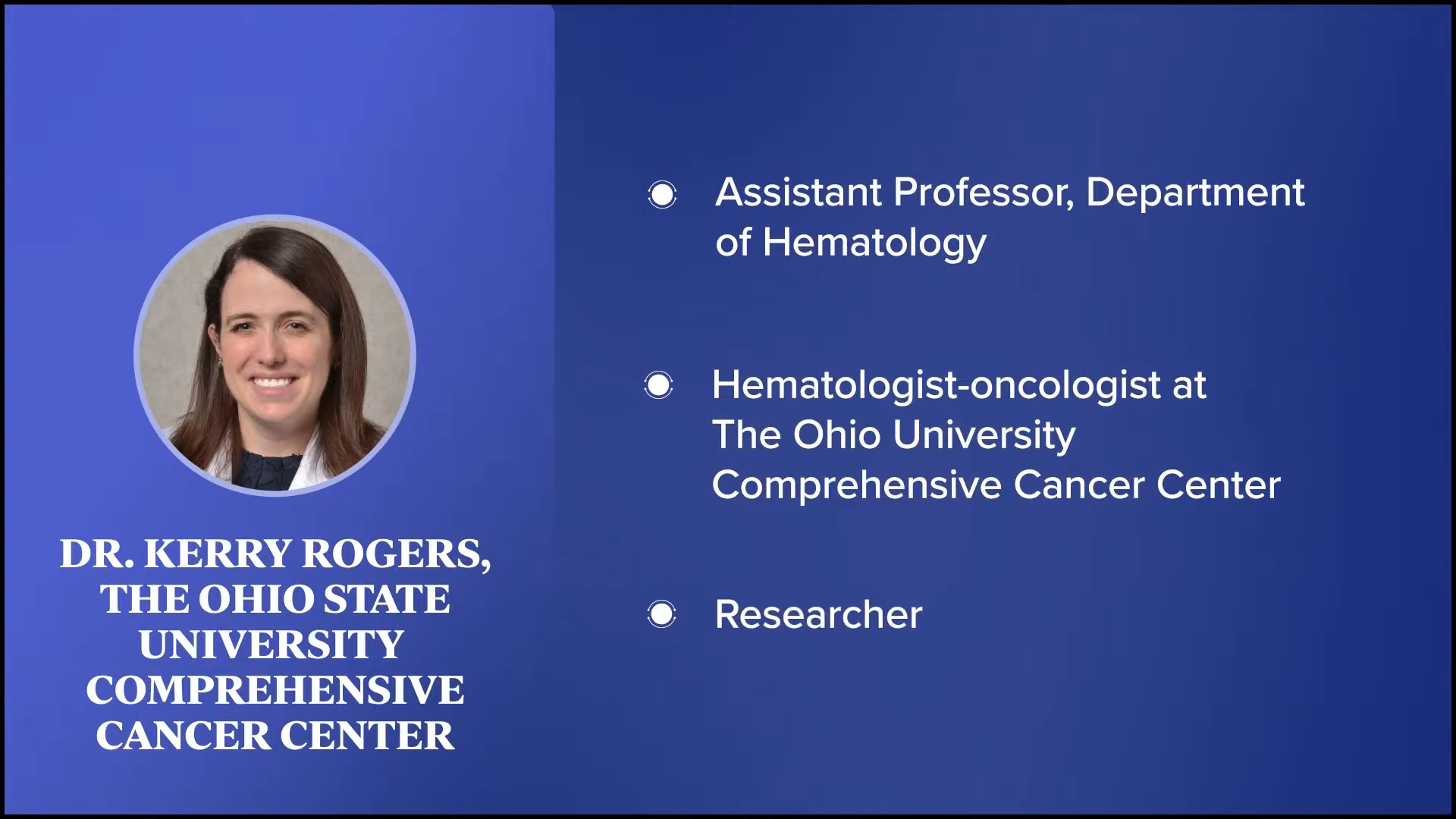
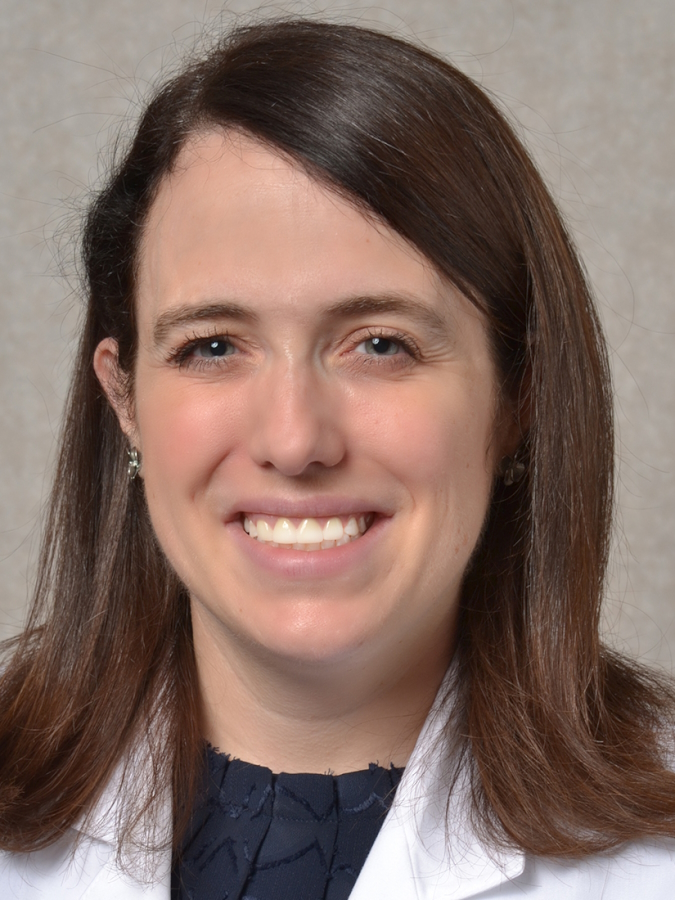
Dr. Kerry Rogers, Hematologist-Oncologist
Jeff: Also joining us is Dr. Kerry Rogers. She’s the assistant professor in the Division of Hematology at The Ohio State College of Medicine and a hematologist-oncologist and researcher at The Ohio State University. Dr. Rogers, why did you choose CLL?
Dr. Kerry Rogers: When I was doing my fellowship in hematology and medical oncology, I had the privilege of taking care of patients in some of the original ibrutinib clinical trials who had been living with CLL for over a decade or two and had experienced a lot of chemoimmunotherapy treatment. They said ibrutinib was the best that they’d ever had in terms of how it impacted their daily lives and so I thought that was intriguing. Now we know that these drugs are not only generally more tolerable but also more effective than chemoimmunotherapy.
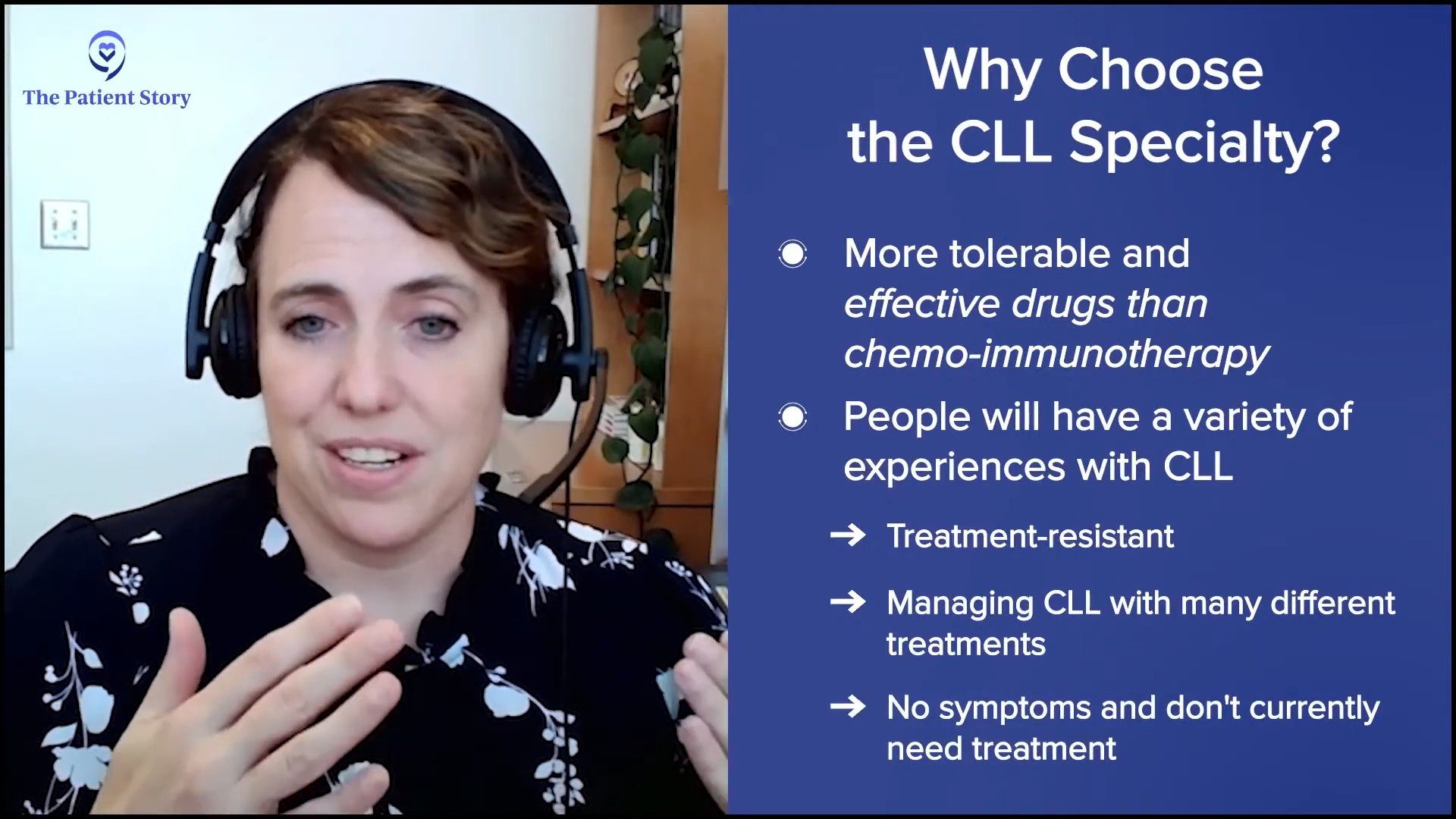
I like the long-term relationships you can have with patients and the variety of experiences with CLL. You have people who are quite ill, who have experienced a lot of treatment, may have had CLL that’s become resistant to some of those treatments, and need to do a lot of things to manage the CLL. You also see people who are living with it who currently do not have symptoms or do not need treatment.
I also like the fact that there are some people you encourage to do what they want with their lives and not focus on having cancer. Mostly, I’d like all my patients to be bothered by CLL as little as possible, but you do get people in a variety of situations and I appreciate that about working in CLL.
Everyone reacts completely differently to the treatments. For most patients, treatment side effects are common and can be impactful. Some of them are temporary, but some of them are more severe.
Impact of Recent Treatment Advancements on Side Effects
Jeff: I participated in a clinical trial where I received intravenous monoclonal antibodies. Like everyone who participates in a clinical trial, I received a stack of informed consent papers that looked to be about a foot and a half thick and described every single side effect that might happen with the administration of that drug.
The first time that I went to get the infusion, I was told to expect that it was going to take four to six hours. Unfortunately, it took 23 1/2 hours for me because I experienced pretty much every single one of its side effects. We got through them all. When the side effects happened, they were treated and we’d hit the reset button and start over again. As I progressed through the clinical trial, the side effects were minimized.
We’re in a different world now. Everyone reacts completely differently to the treatments. For most patients, treatment side effects are common and can be impactful. Some of them are temporary, but some of them are more severe. Sometimes treatment or even hospitalization is required. And then some people, for whatever reason, never have a single side effect.
Dr. Davids, the treatment landscape for CLL patients has truly evolved in the past couple of years. Could you discuss these advancements and how the side effects of CLL therapy, more specifically the BTK inhibitors, have changed over time?
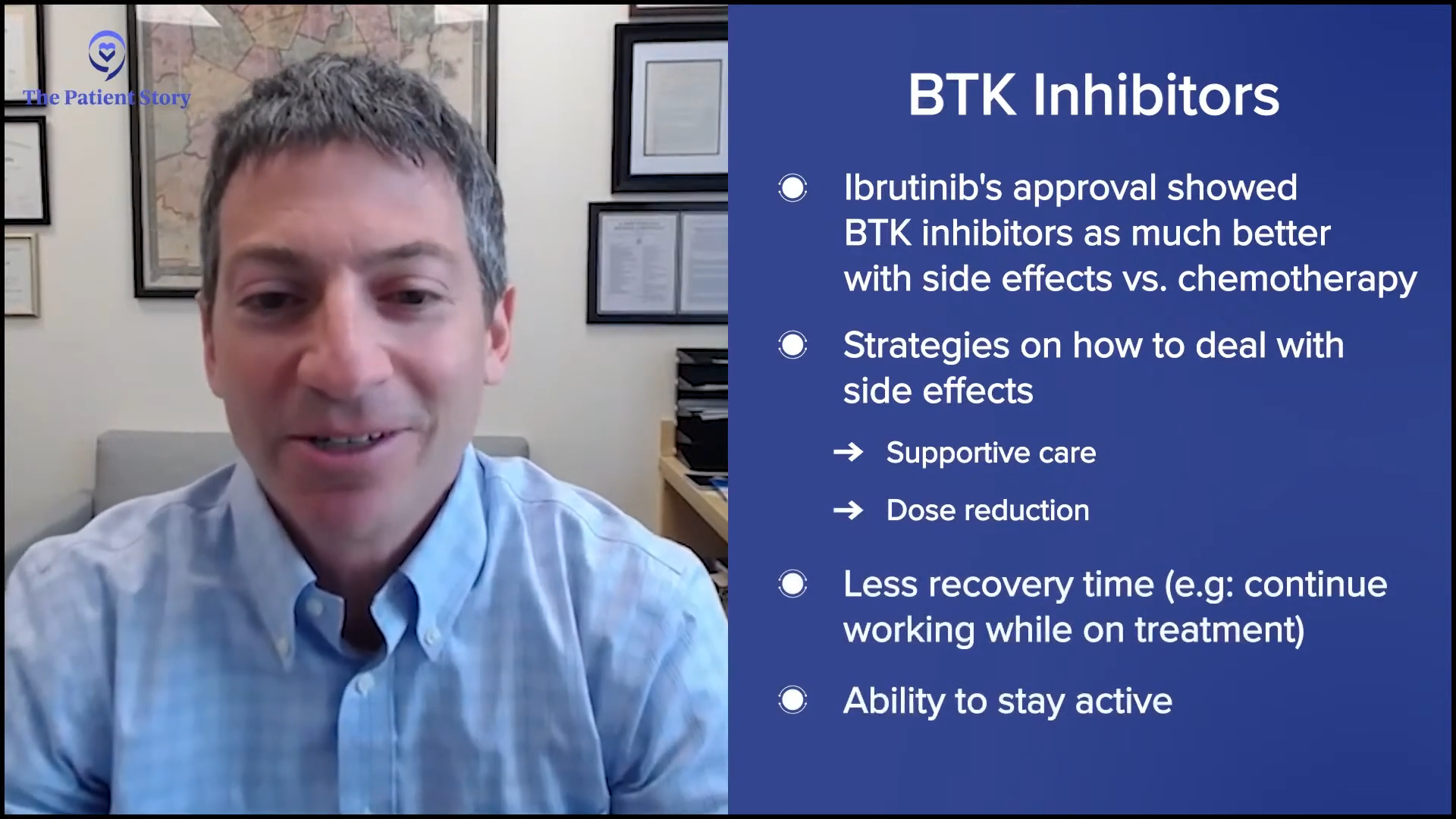
Dr. Davids: To contrast with the older chemotherapy-based approaches, I told patients, “We’re going to start treatment. You’re going to need to take probably 6 to 12 months off from work and go on disability. Your whole life is going to change over this timeframe, but eventually, you’ll get better and get back to what you’re doing.”
When BTK inhibitors like ibrutinib first entered into trials, we quickly realized that these drugs are much better tolerated than the older chemotherapy-based regimens. There may be some side effects that arise, but we’ll deal with them. We’ll use various supportive care measures. We may need to reduce the dose, but you should be able to keep doing the things you want to be doing. You can usually keep working while on treatment.
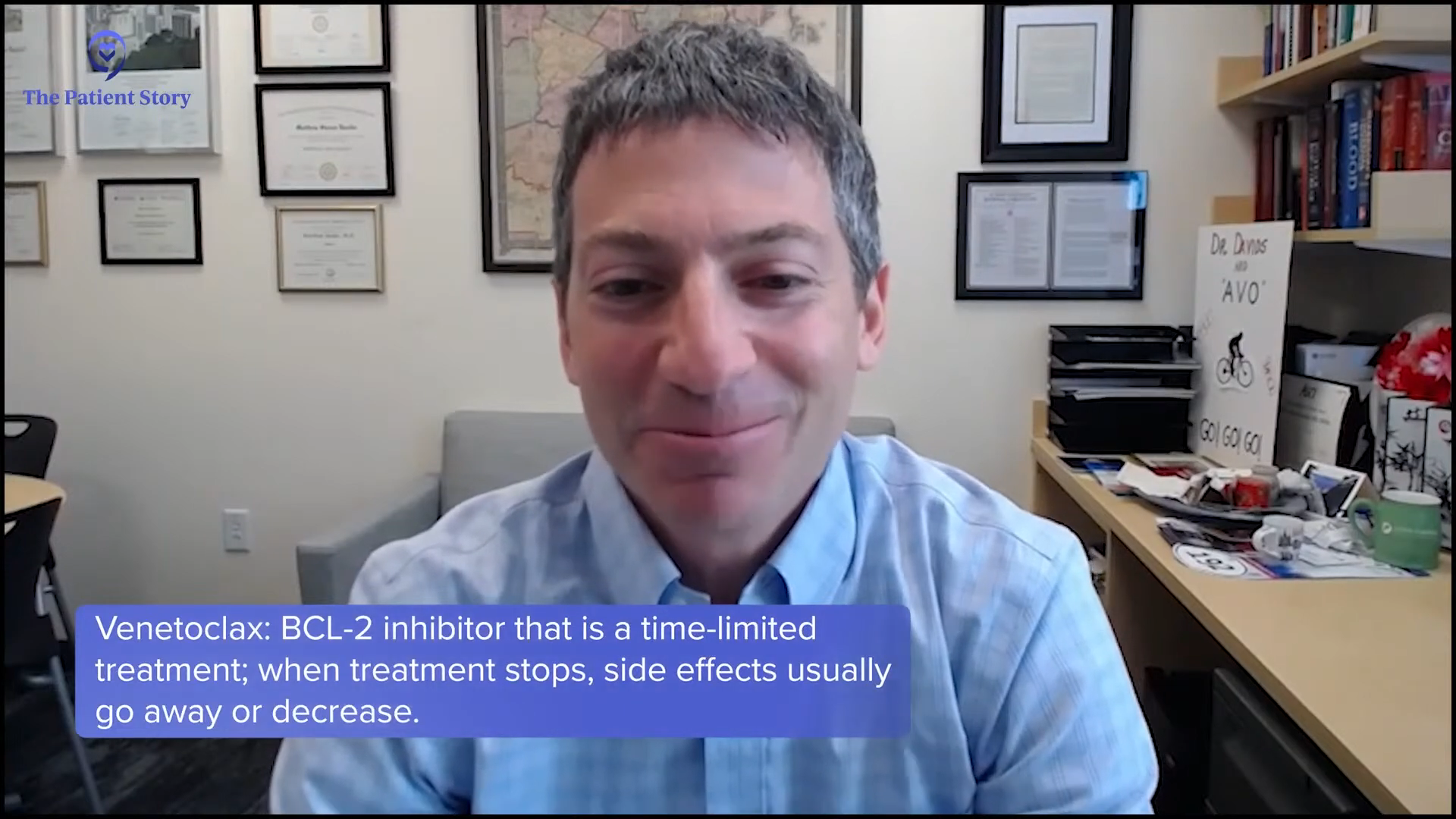
We have venetoclax, which we usually give in a time-limited fashion for one or two years, and it has a different side effect profile than the BTK inhibitors. The nice thing about that is with a time-limited treatment, when we stop the treatment, usually the side effects go away or are minimized at least. There are lots of different options.
Jeff: When we first started treating CLL, the treatments were pretty drastic and the side effects were pretty intense for the majority of people. Now, with the new treatments, specifically the BTK inhibitors and drugs like venetoclax, the side effects aren’t as intense and are usually easier to treat. Is that a fair statement?
Dr. Davids: Yeah, that’s a fair statement. There are rare situations where you can have more severe side effects, but for the most part, most of our patients are doing very well with these new targeted therapies.
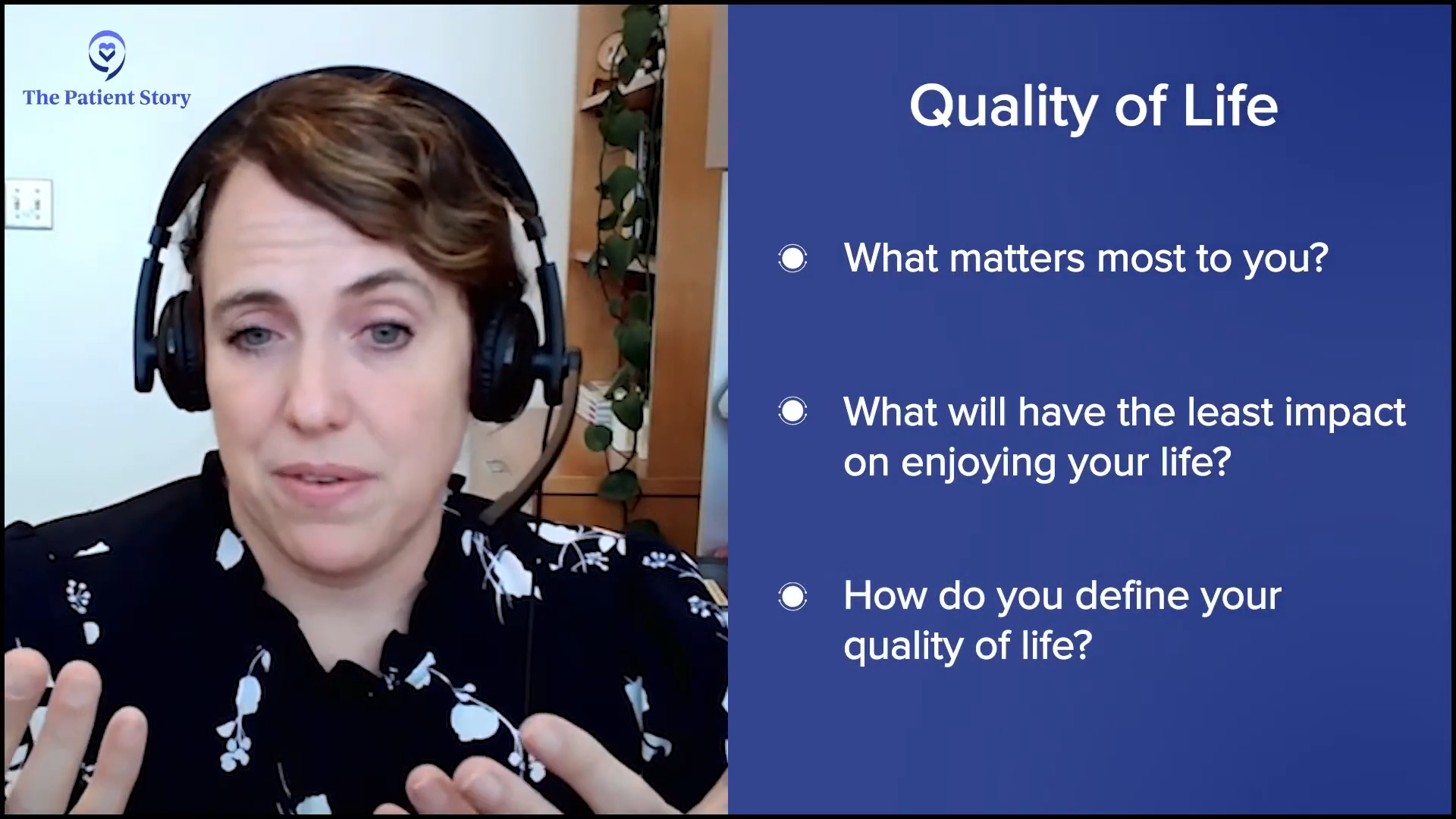
Relationship Between Side Effects and Quality of Life for CLL Patients
Jeff: For me as a patient, quality of life is at the top of my list. If I can’t do the things that I want, we’re going to have a conversation and figure out how to get there. Quality of life is a complex and personal concept, but it’s directly intertwined with cancer treatment side effects. Dr. Rogers, how do you define the quality of life for a CLL patient and how do the side effects of treatment impact this in your experience?
Understanding what matters most to the patient or what’s going to have the least impact on their enjoyment of their life is what we do.
Dr. Rogers: If we’re trying to decide between two targeted agents that are both good options with different side effects, understanding what matters most to the patient or what’s going to have the least impact on their enjoyment of their life is what we do and it can be different for different people.
With a BTK inhibitor, some of the common side effects are bleeding, bruising, joint pains, and abnormal heart rhythms like atrial fibrillation. I have a few patients where atrial fibrillation has been much harder for them than the CLL was at any point. If you’ve had someone who’s experienced atrial fibrillation before and it was bothersome to them, they’re going to try to avoid that treatment.
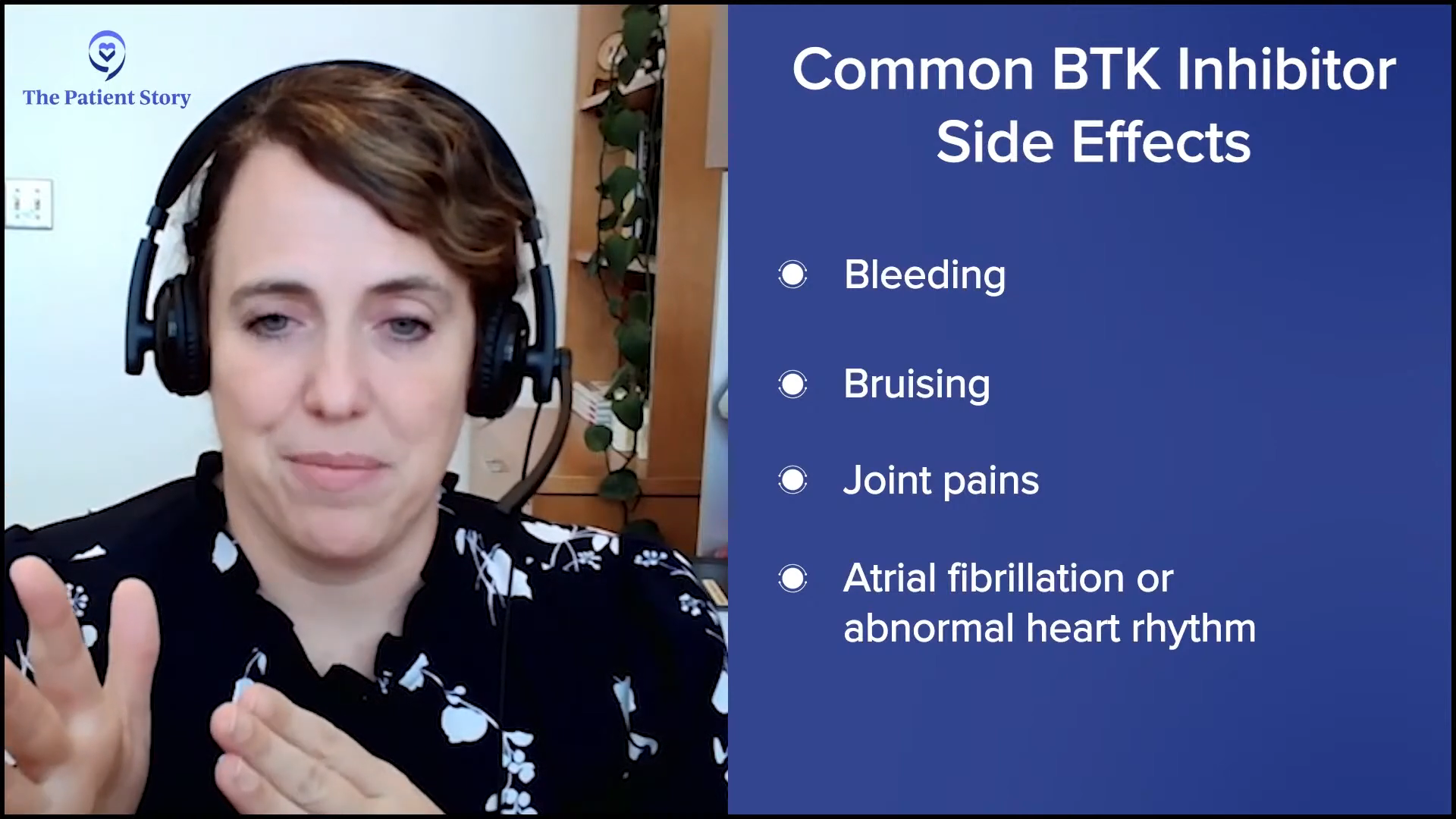
Treatment Side Effects vs. Treatment Schedule
Dr. Rogers: Meanwhile, for venetoclax, quality of life isn’t treatment side effects but also treatment schedule. When given as a first treatment, venetoclax is given for a year with obinutuzumab, which is a monoclonal antibody, and that requires an eight-week start-up. It was very striking what Dr. Davids said that we try hard now to make it clear to patients that we don’t want them to be disabled by the treatment they’re going through, even temporarily.
We mostly want you to be able to live your life and do what you want.
People have told me they worry about their lives being over and not being able to do anything when they do treatment. I usually tell them that some people get severe side effects that have to be dealt with, but we mostly want you to be able to live your life and do what you want. That’s how I define quality of life as a physician. I want my patients to be living their lives and doing the things they enjoy with minimal impact from their treatment.
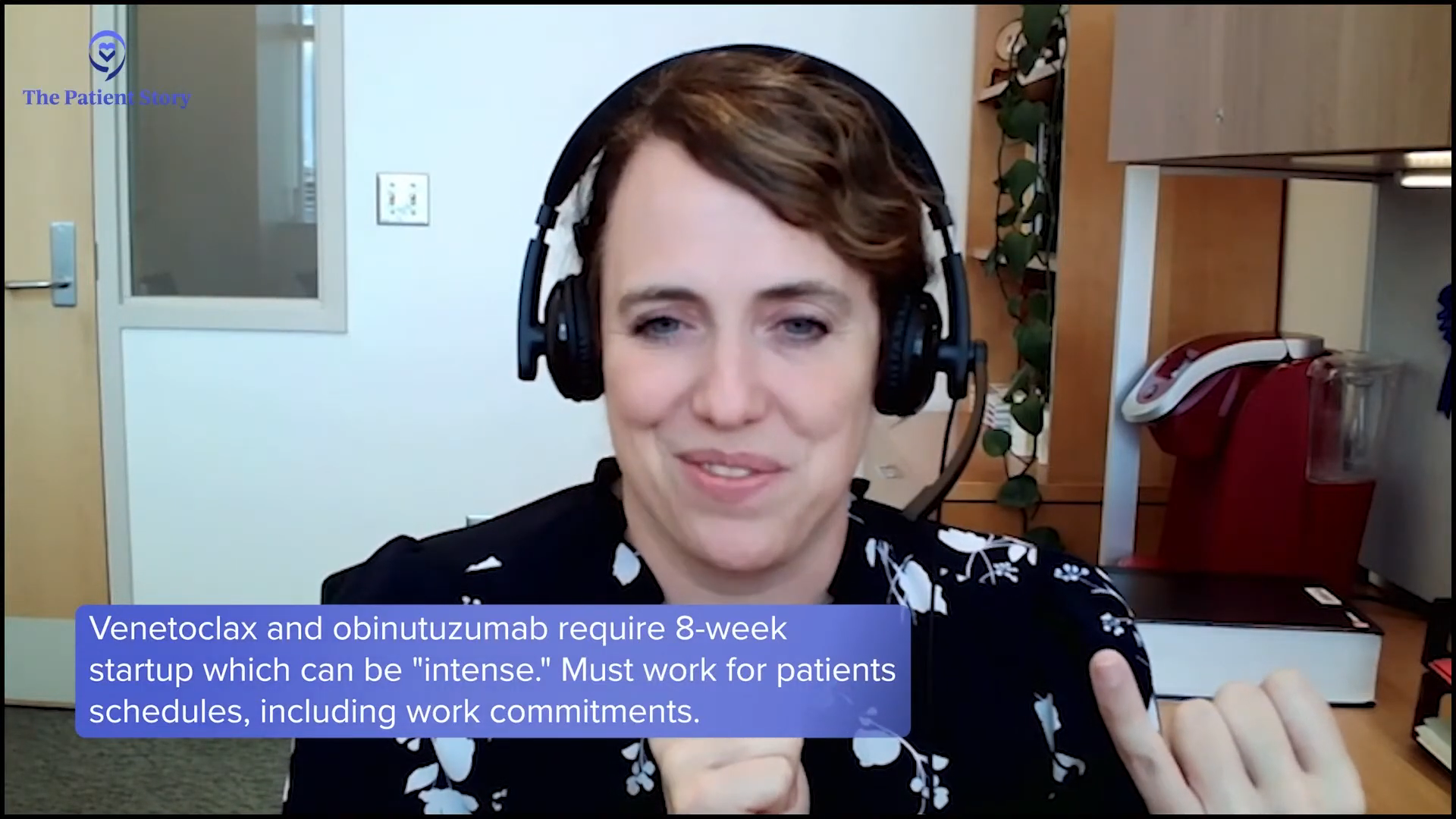
These days, one of the biggest impacts can be the treatment schedule. You can continue to work or play golf, but you still have to come for visits and that’s the biggest thing that changes with treatment. The venetoclax and obinutuzumab regimen requires an eight-week start-up, which can be intense. I’ve had patients who choose not to do that because they don’t want to take time off work to go to infusion visits.
I’ve also had patients take online meetings during infusion visits, which I’m fine with as long as they’re still engaged in their medical care. I don’t tell anyone they have to work during treatment but some people love their job and don’t want to step away from it.
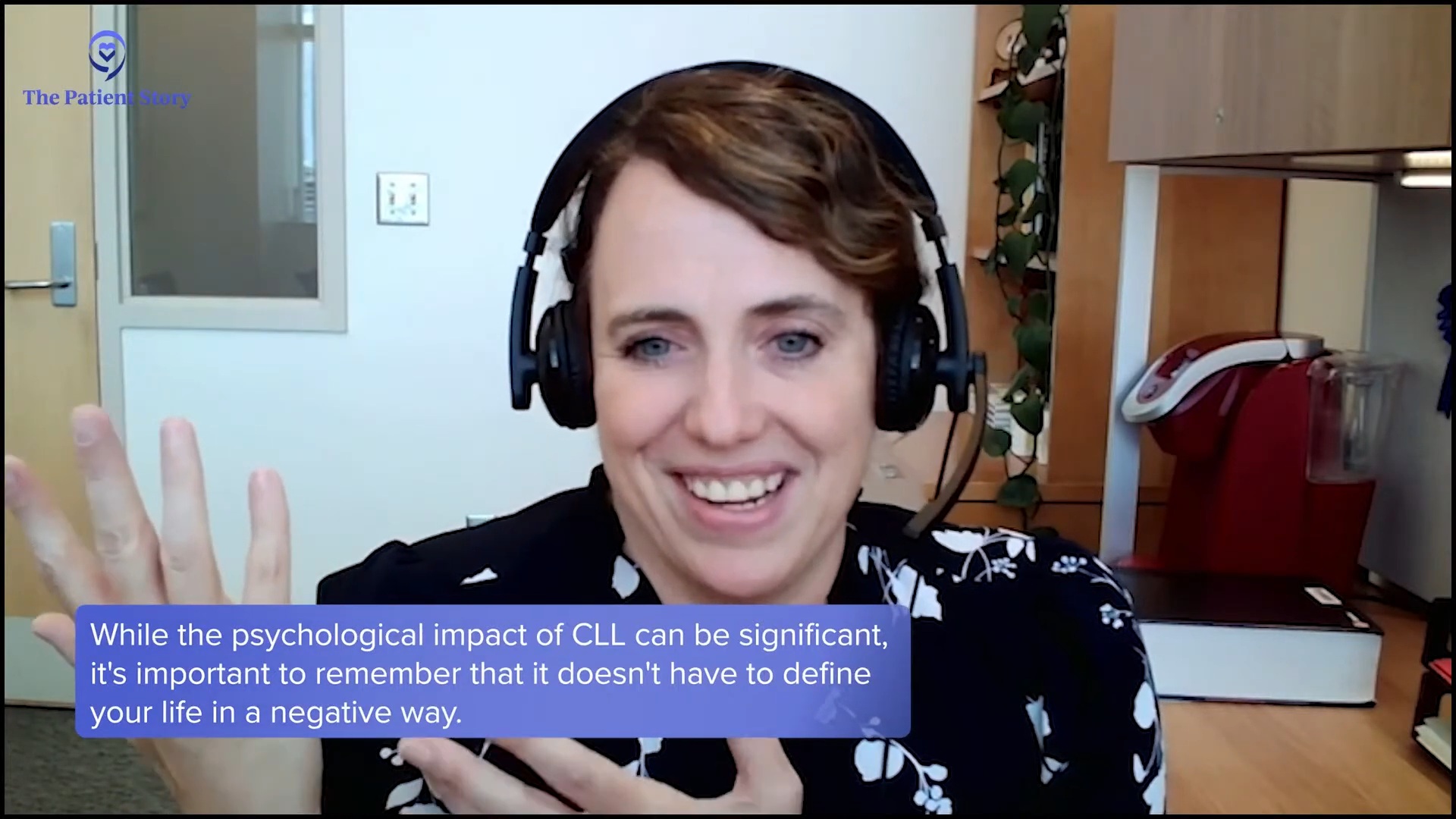
Quality of life is defined by the person and I try to minimize the impact of what we’re doing for CLL on people’s enjoyment of their life, whatever that is. Something that isn’t talked about a lot is trying to minimize the psychological impact of starting treatment. We make sure people know that treatment doesn’t mean that they won’t get to do the things they like, even though scheduling is something they’re going to have to deal with for the most part.
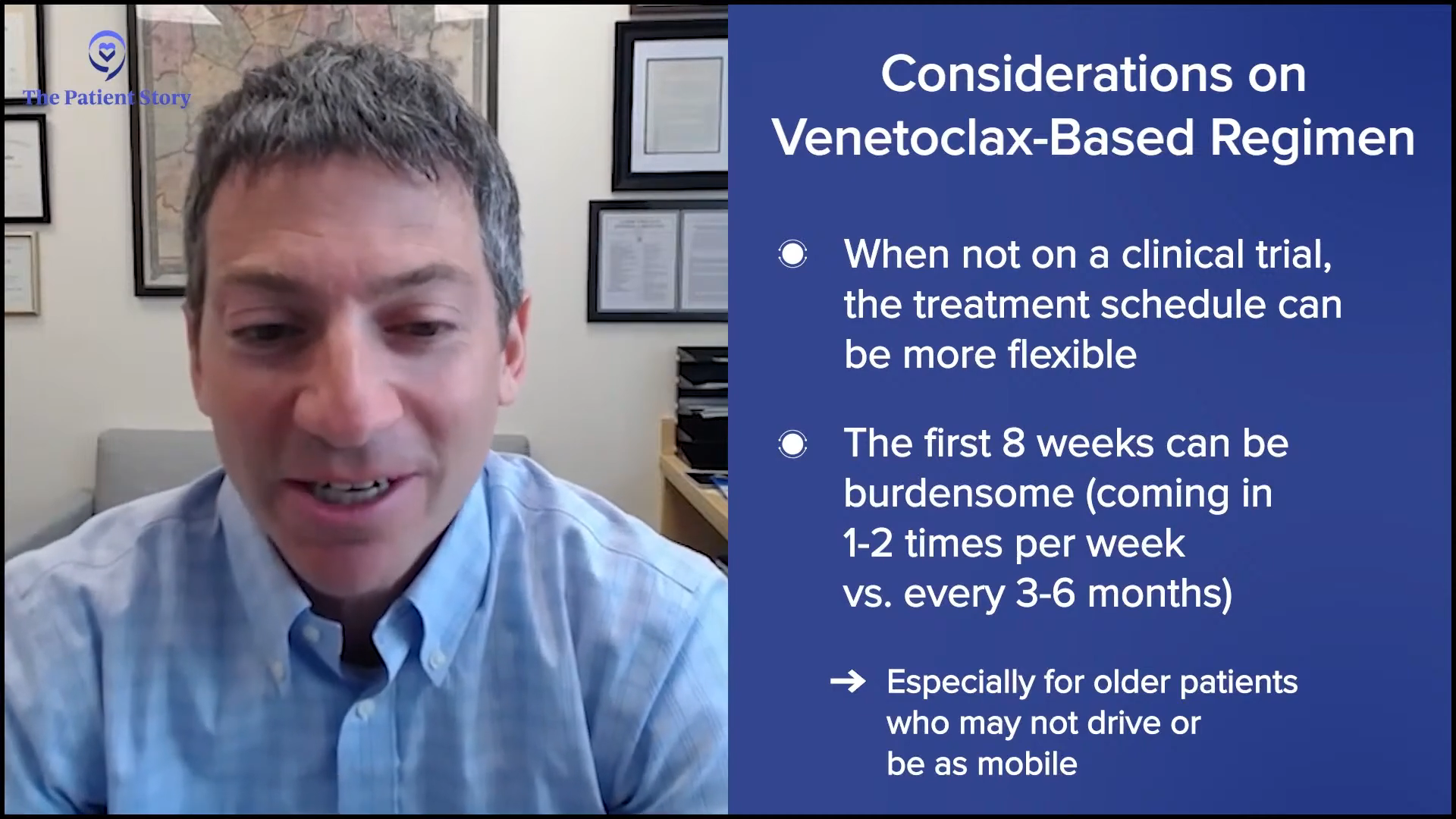
Dr. Davids: If they do want to do the venetoclax-based regimen, it’s a bit disruptive to their schedule. When patients aren’t on a clinical trial, I try to have some flexibility so that if they have an important event, we can delay by a day or two, but I try to keep them on schedule. It can be a little more challenging when patients are on a clinical trial because we need to rigorously adhere to a specific schedule.
For some patients, it doesn’t make sense to invest eight weeks or so in coming in for frequent visits. A lot of our patients are used to being seen every three to six months. If we tell them to come in once or twice a week for a couple of months, that can be challenging. Some of our older patients don’t drive anymore and need to get rides or live far from the center.
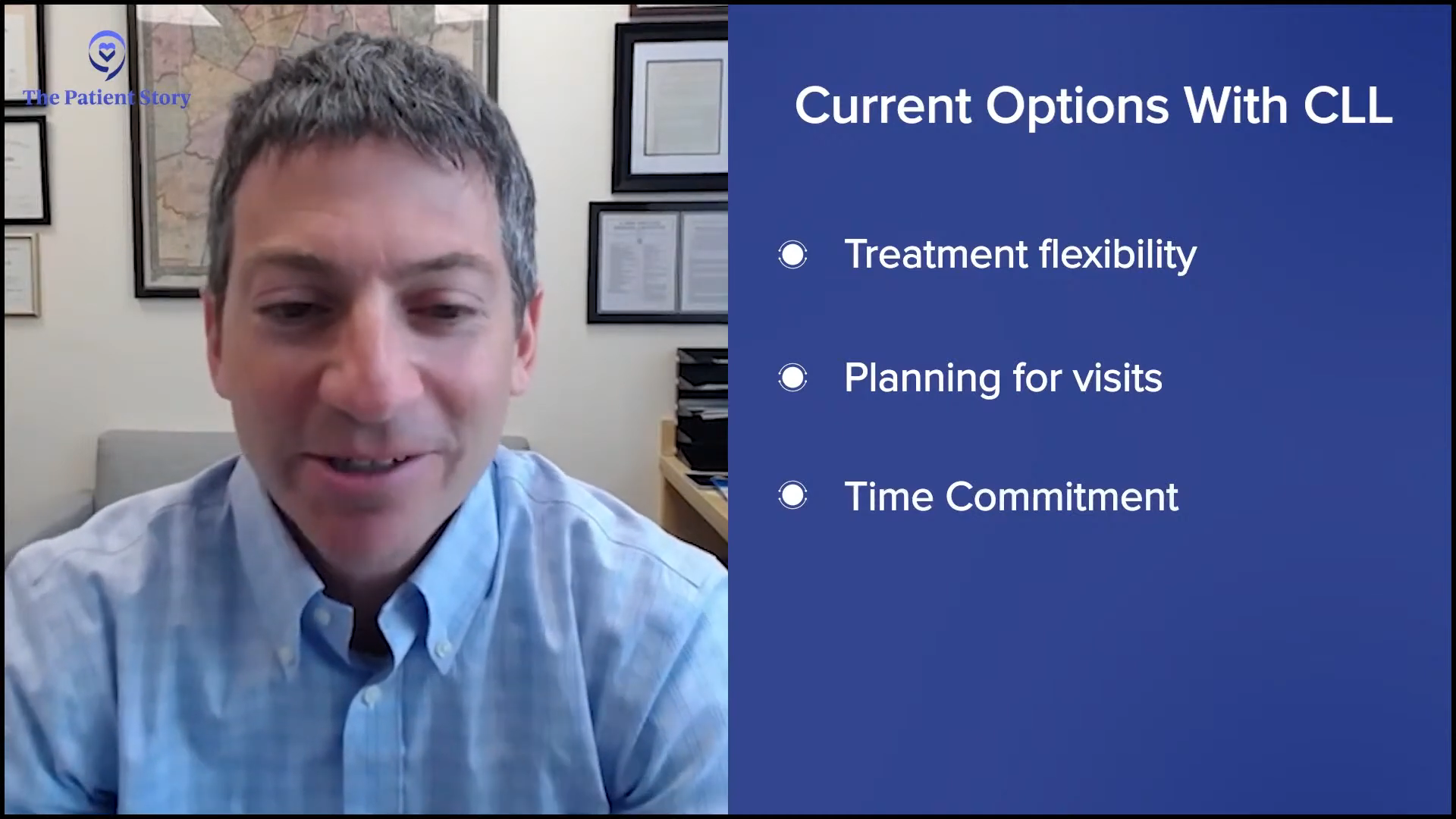
One of the beauties of the CLL treatment setting right now is that we have other options. Patients like that can go on BTK inhibitors. They require minimal monitoring and for some patients, that’s nice for their quality of life. They come in a couple of times early on to make sure everything’s going well and they can get back to their three- to six-month interval schedule.
Having different options for different patients is great. We’re on the precipice of having a new regimen approved in the US, which is a combination of acalabrutinib, one of the BTK inhibitors, with venetoclax. That’s going to be a nice advance because it will offer the opportunity for an all-oral, time-limited regimen.
One of the beauties of the CLL treatment setting right now is that we have other options… Having different options for different patients is great.
Right now, if you want all-oral therapy, you have to go with a BTK inhibitor and take it long-term for many years or you can go with obinutuzumab and venetoclax and have that opportunity for the one-year, time-limited therapy.
If approved, which we think it likely will be, acalabrutinib with venetoclax will be two pills. It’s a time-limited treatment of about 14 months or so and then you’re done. You don’t need to go through obinutuzumab infusions and that’s going to be a nice option to have for patients as well.
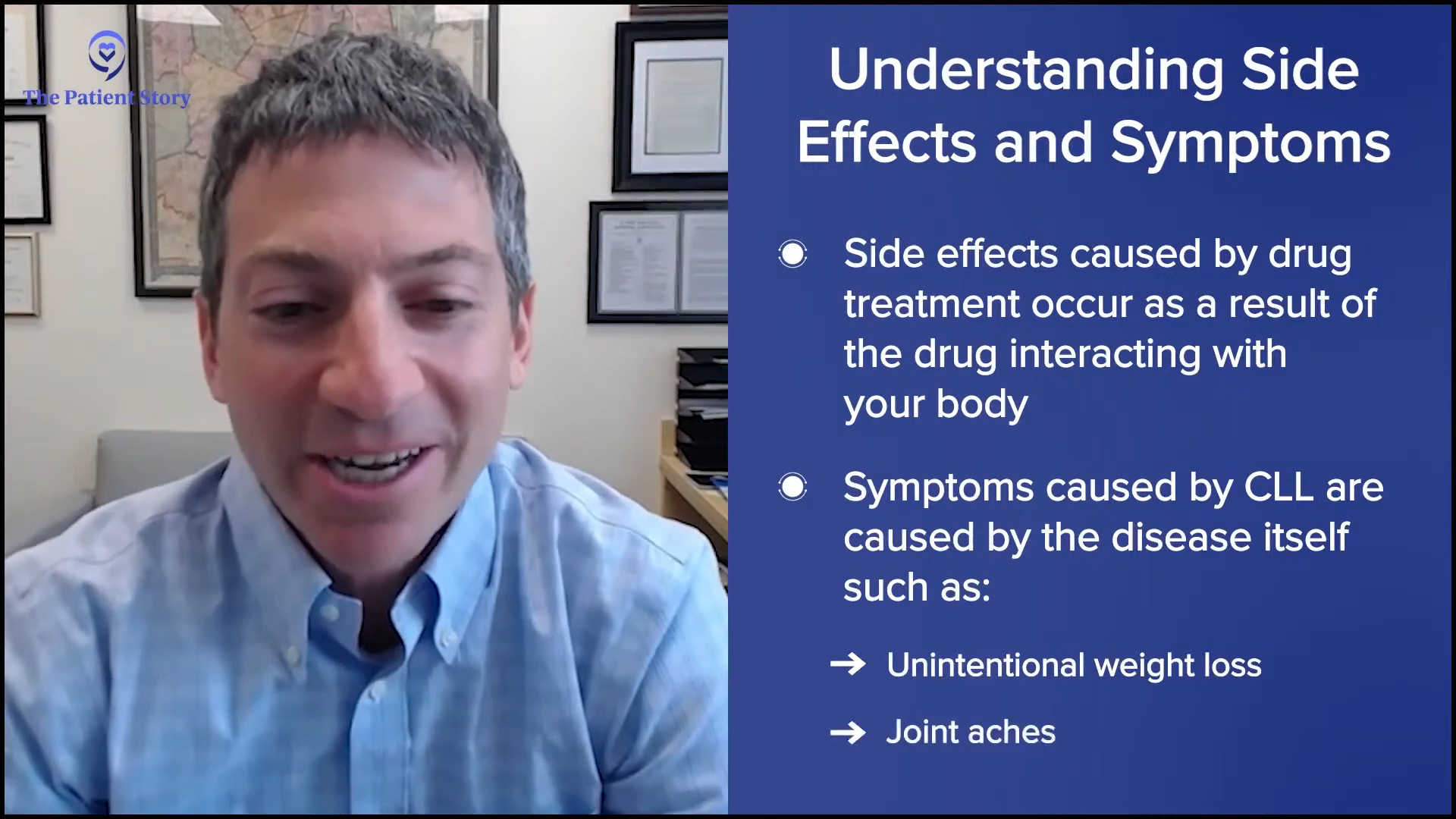
Dealing with Side Effects
Jeff: Whether you’re being treated, waiting for treatment, relapsed, or in remission, all CLL patients are dealing with some kind of symptom. It’s a fact of life, whether we call it fatigue, low platelets that make people bleed easily, joint pain, or AFib. Dr. Davids, what kind of practical advice do you give patients for dealing with those symptoms?
Dr. Davids: The disease itself can cause a lot of symptoms. There’s an interesting study where they took CLL patients who didn’t need treatment and randomized them to an early intervention approach with ibrutinib versus a placebo. It’s a rare opportunity in CLL to see what happens in a population being treated with a placebo.
As they stay on therapy longer and the CLL gets into a better remission, they tend to start to feel better overall.
In that study, there was a 90% rate of side effects in the patients on ibrutinib and a 90% rate of side effects in the patients on placebo. It was the same in both arms. That speaks to how the disease itself can cause a lot of issues, like fatigue, unintentional weight loss, sweats, and joint aches.
I counsel my patients that as they stay on therapy longer and the CLL gets into a better remission, they tend to start to feel better overall. They’ll develop better energy, their appetite may come back, they may gain some weight back if they’ve lost weight, and sweats can go away.
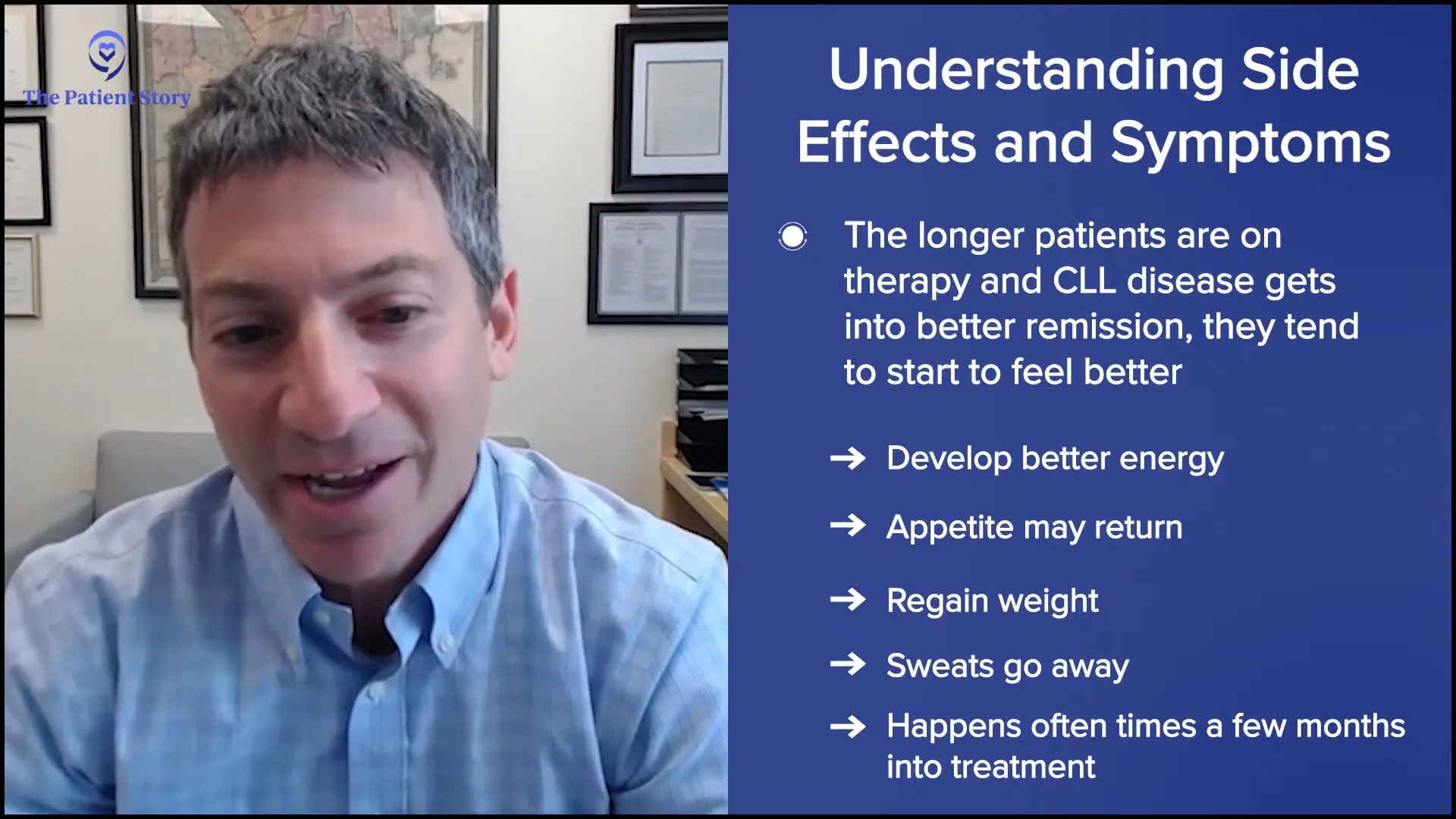
One of the more challenging periods is getting started on treatment because that’s when you have some side effects from the drugs and there’s still a lot of CLL around, so they may not be feeling great. As they get a few months into treatment, the CLL starts to get better. It involves counseling and coaching them through that. Hold out and be optimistic. It’s going to get better with time. For most patients, they may start feeling better pretty quickly, even within a few weeks of starting on therapy, because of disease control.
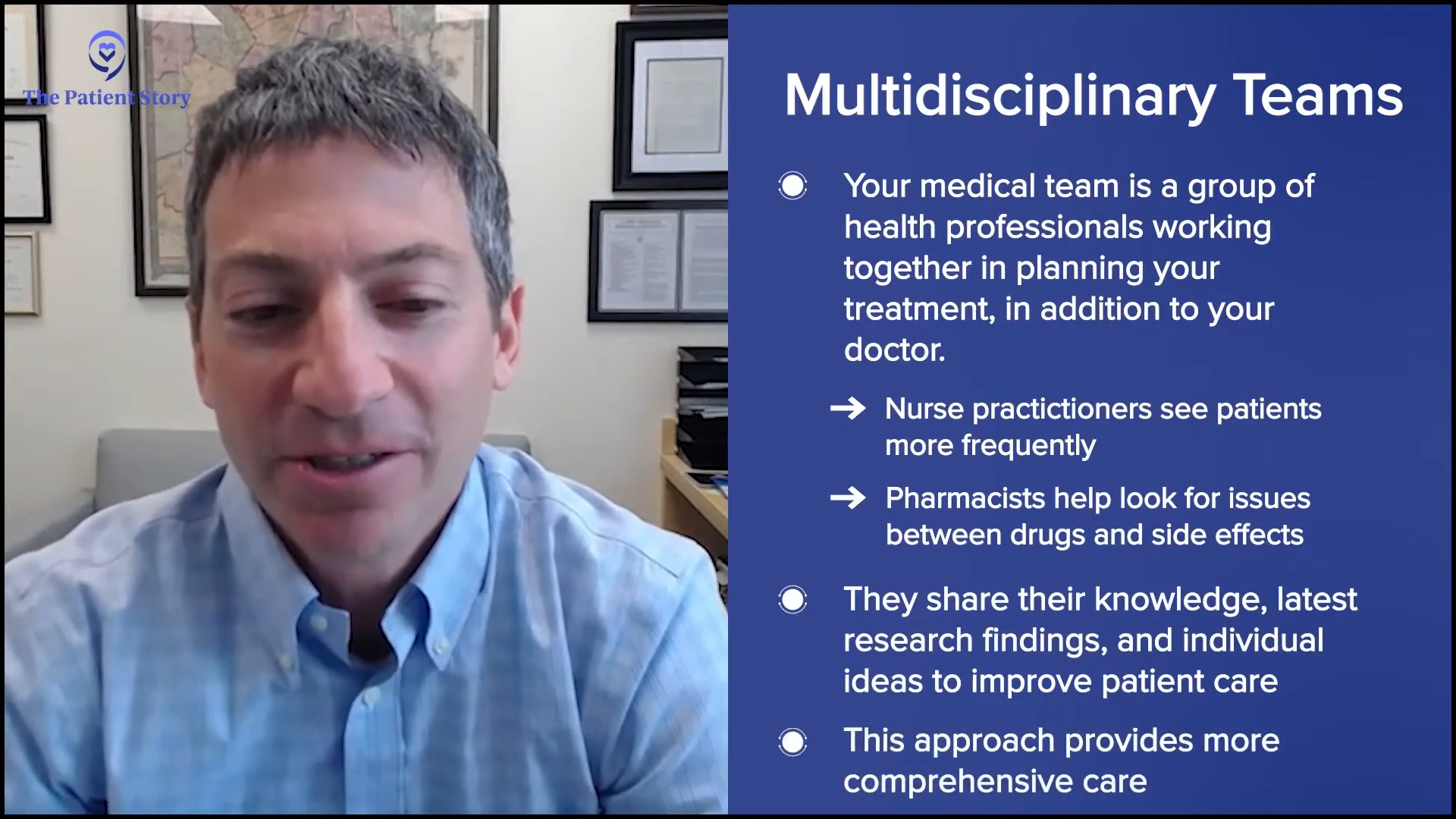
We have a very good multidisciplinary team. We have a great nurse practitioner who’s seeing the patients often more frequently than I do. We have pharmacists who help and look for issues with the drugs and side effects. The caregivers for the patient are a key part as well. It’s a team effort, but we do a pretty good job of getting patients through that more difficult period and to a better place where they’re feeling better.
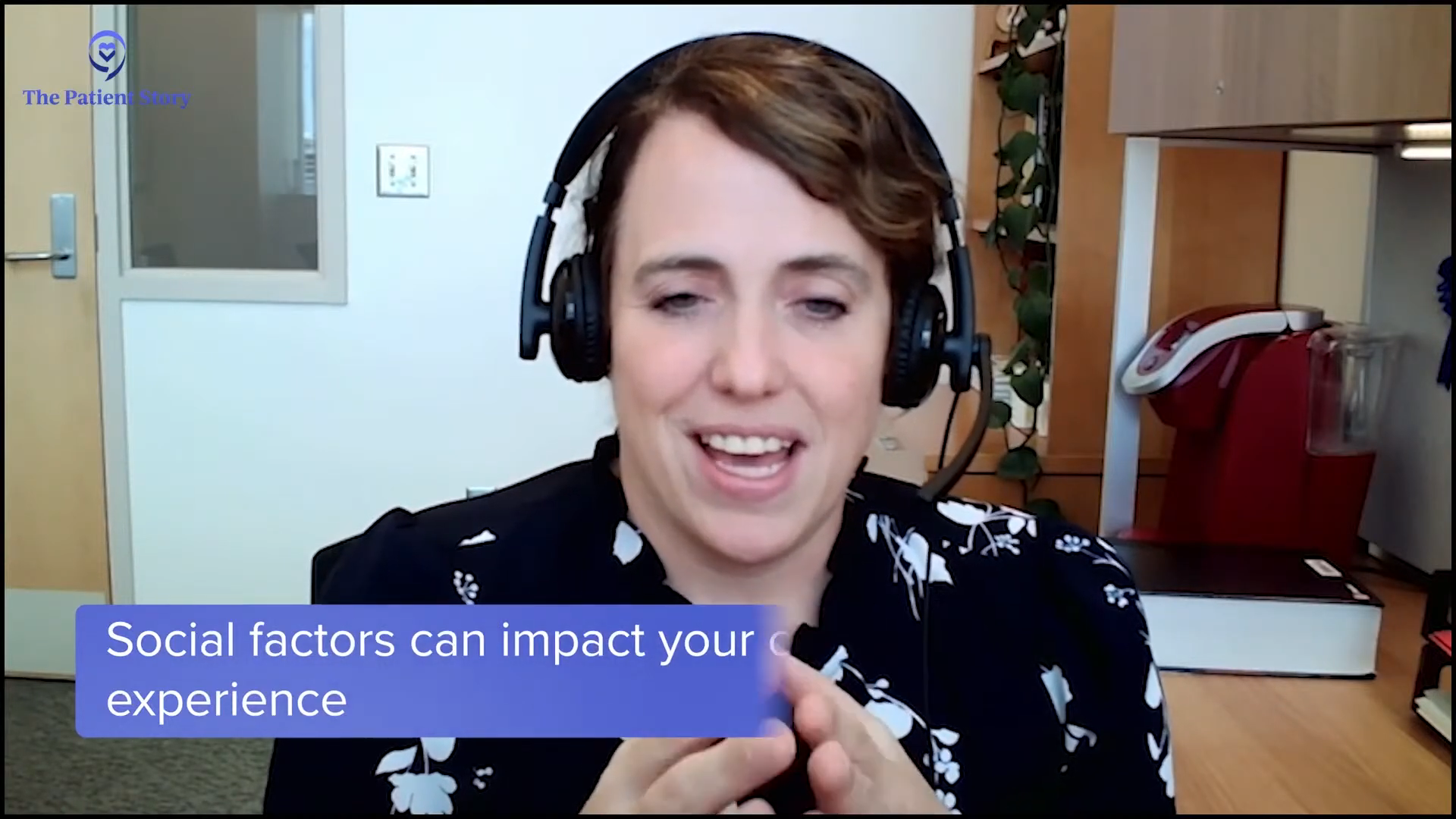
How Can Patients Actively Participate in Their Care?
Jeff: Dr. Rogers, it’s hard for a doctor and the care team to know how to guide a patient through their side effects if they don’t know they exist. How do we do this? What does a patient have to do to get the best possible side-effect care from you and your team?
Dr. Rogers: One thing Dr. Davids said that’s important is I’m not the only person. Different members of the team are asking about side effects. Nurses, nurse practitioners, and physician assistants help too.
The nurse practitioner I primarily work with is a man and sometimes, patients tell him things that they won’t tell me or vice-versa. Sometimes the gender of the care provider or the care team member can make a difference in people disclosing side effects.
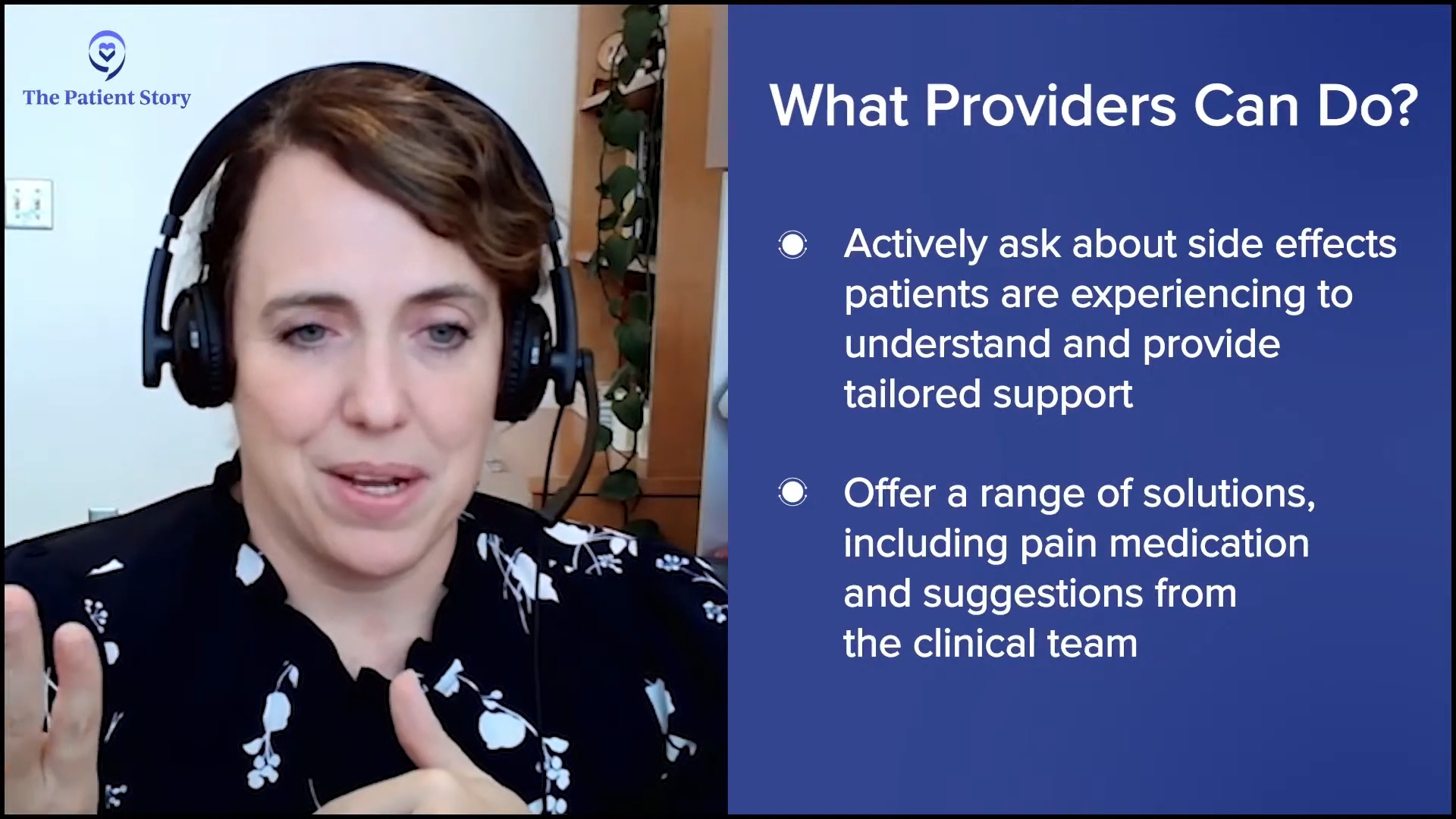
Asking about specific side effects that we know are common can help because I find people disclose more. If there’s one that they perceive is ruining their quality of life, we ask about it so we can get the spectrum.
Sometimes there are side effects that are bothersome to one person that aren’t to somebody else, like joint pain. We ask about it, learn about it, and suggest pain medication. But if the person’s happier living with it than trying any sort of intervention, I’m okay with that.
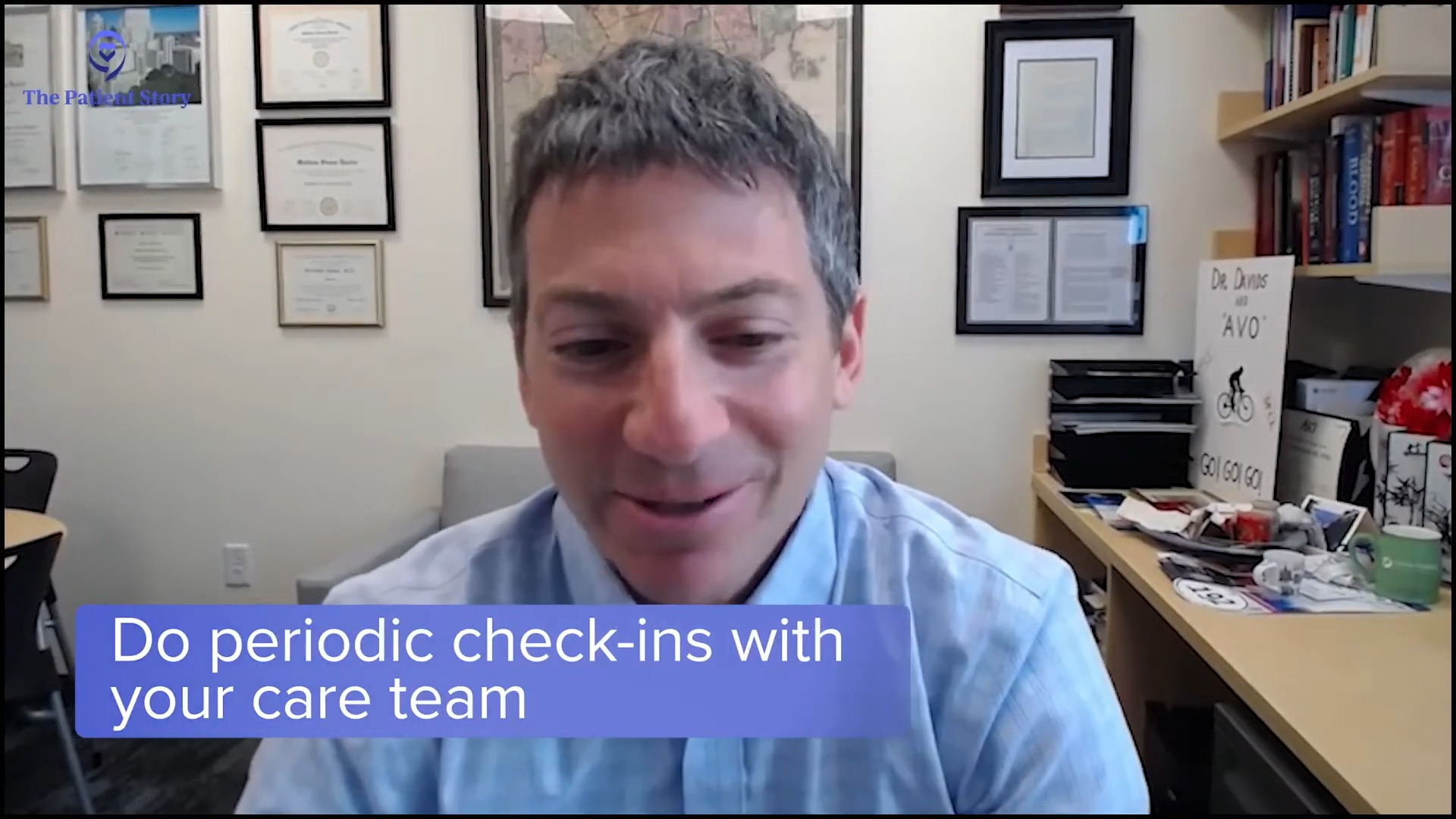
Effective Patient-Physician Communication
Jeff: Dr. Davids, it sounds like in the current landscape, most side effects are fairly easily managed for CLL patients. Let’s talk about how you deal with these side effects.
Dr. Davids: Every drug is different. Every side effect is different. Every patient is different. Sometimes we see more significant side effects with BTK inhibitors where we run into issues with bleeding and that can be serious.
Being very proactive and communicating with your doctor about what’s going on is important.
One thing that’s very important for patients on BTK inhibitors is to know that if they need any kind of surgical procedure, they need to stop taking their BTK inhibitor before and after the procedure. It’s helpful for patients to check in with us because every procedure is different and may require a different length of hold.
I have seen some patients run into issues where they forgot to call and ask us. They were taking their BTK inhibitor and had pretty serious bleeding issues after surgery. It’s about communication and anticipation. We’ve had situations where we’ve had to postpone surgeries. Being very proactive and communicating with your doctor about what’s going on is important.
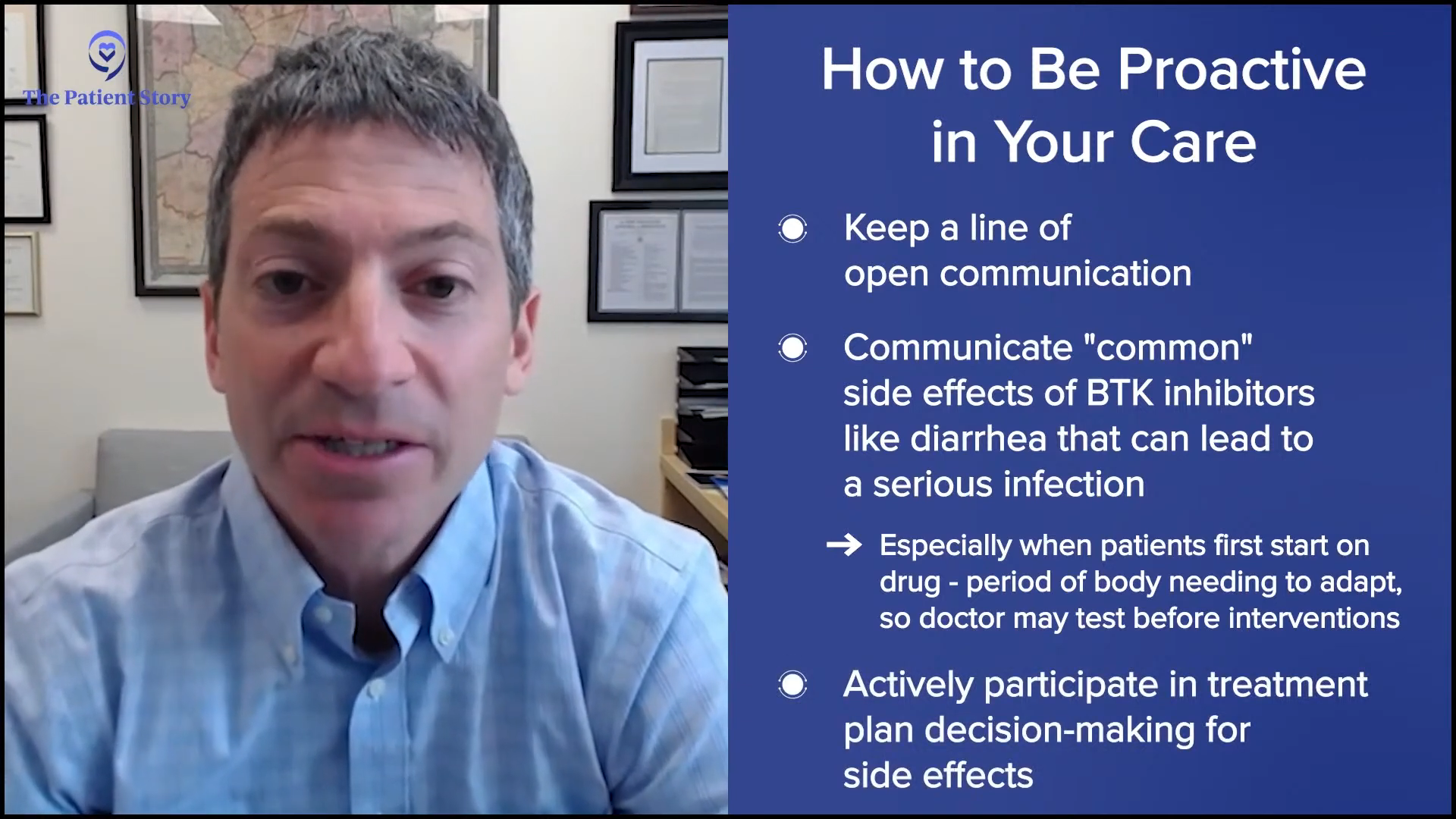
Another common one that I see with venetoclax and BTK inhibitors is diarrhea or loose stools when patients are first getting started on these drugs. There’s a period when your body needs to adapt to the drug.
If it’s pretty significant diarrhea, we usually want to do some testing first before we do interventions. We’ll look for certain infections, like C. diff, which can be a more serious infection. It’s usually not there, but we like to make sure that’s not there before we recommend things like loperamide, which slows down the bowels.
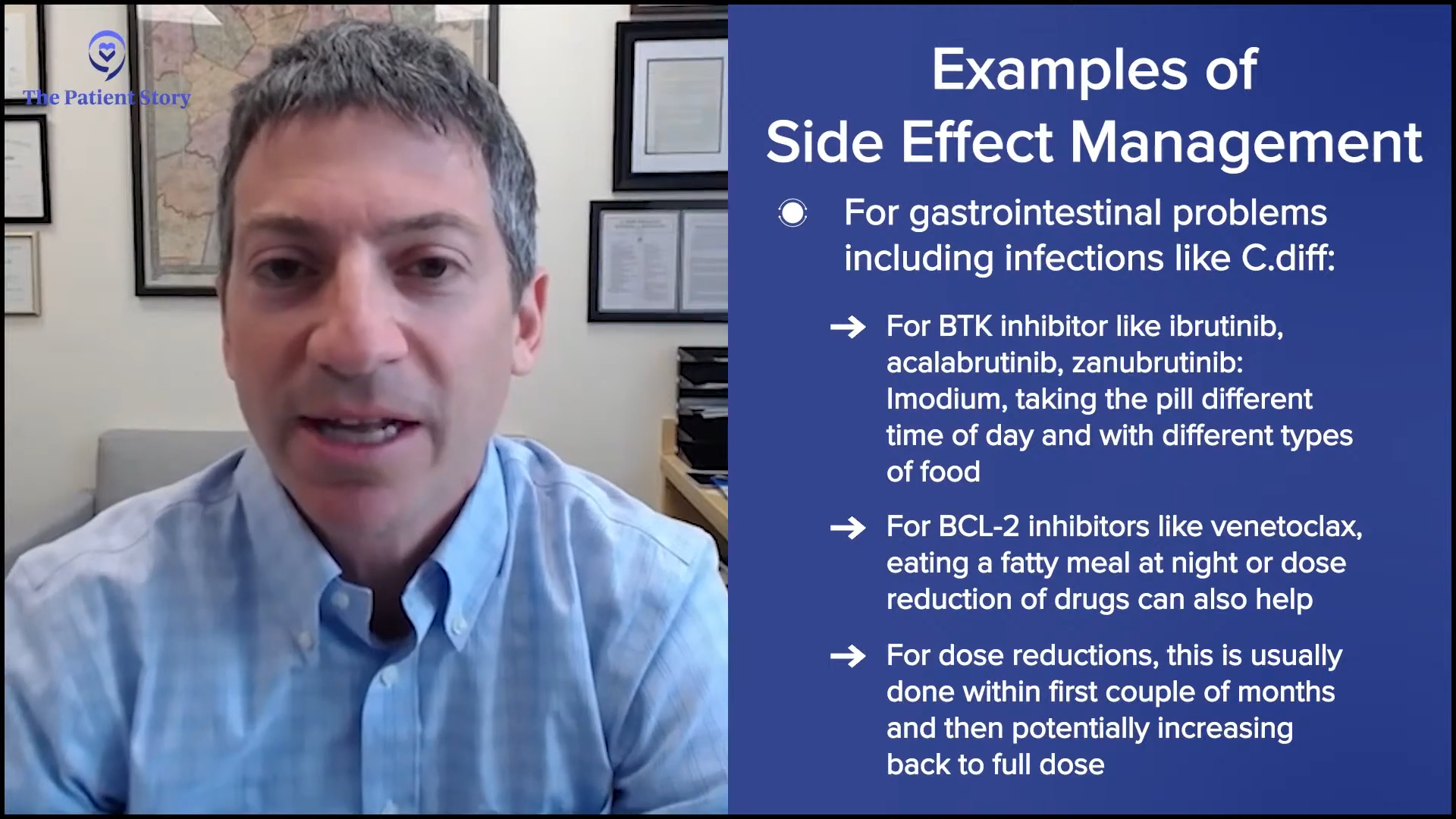
There are little tricks as well. Sometimes taking the pill at a different time of day or with a different type of food can be helpful. With venetoclax, I’ve had luck with patients taking it with a fatty meal at night and when they wake up, they feel better and not having diarrhea during the day.
Sometimes we need to reduce the dose of the drug. I do find that it settles within the first couple of months. Most patients can then back off on loperamide and get back up to the full dose of venetoclax.
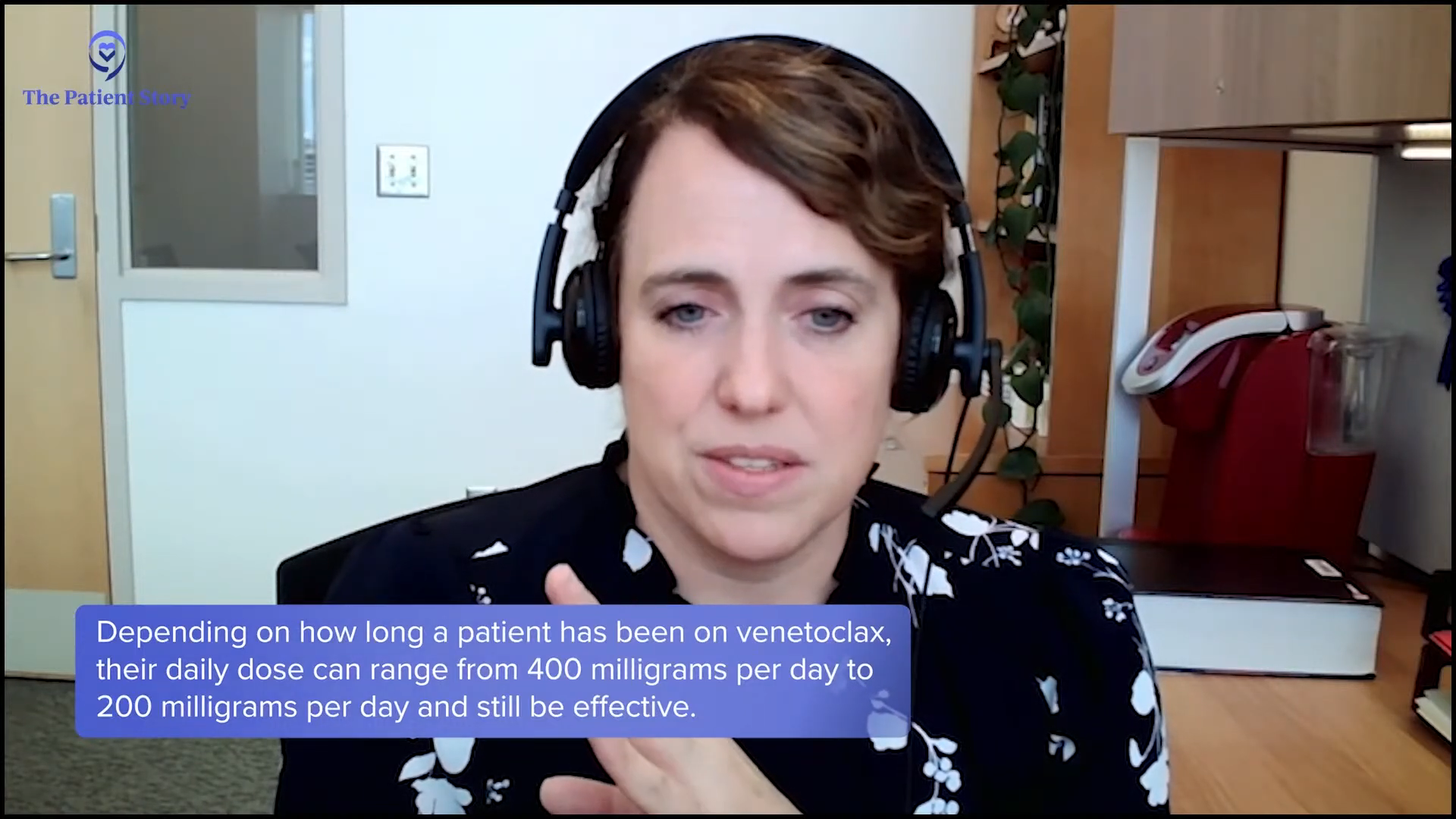
Overcoming the Fear of Dose Reduction
Jeff: Dr. Rogers, for whatever reason, a lot of patients are uncertain and fearful regarding dose reduction because it introduces a cloud of uncertainty to what’s going on.
Dr. Rogers: This is true across other cancers as well. People worry about dose reduction largely because they worry that the treatment will stop being effective if the dose is reduced.
With venetoclax, for example, the target dose for most people who don’t have drug interactions with it is 400 mg a day. However, when people have been on it for a while, there’s an efficacy at 300 mg or even 200 mg. If you’re taking 100 mg twice a week, you start to worry that it’s not going to work. There’s a point where you get to a dose where most people think that’s not going to be effective or with BTK inhibitors, you’re not going to have occupancy or the inhibitory action.
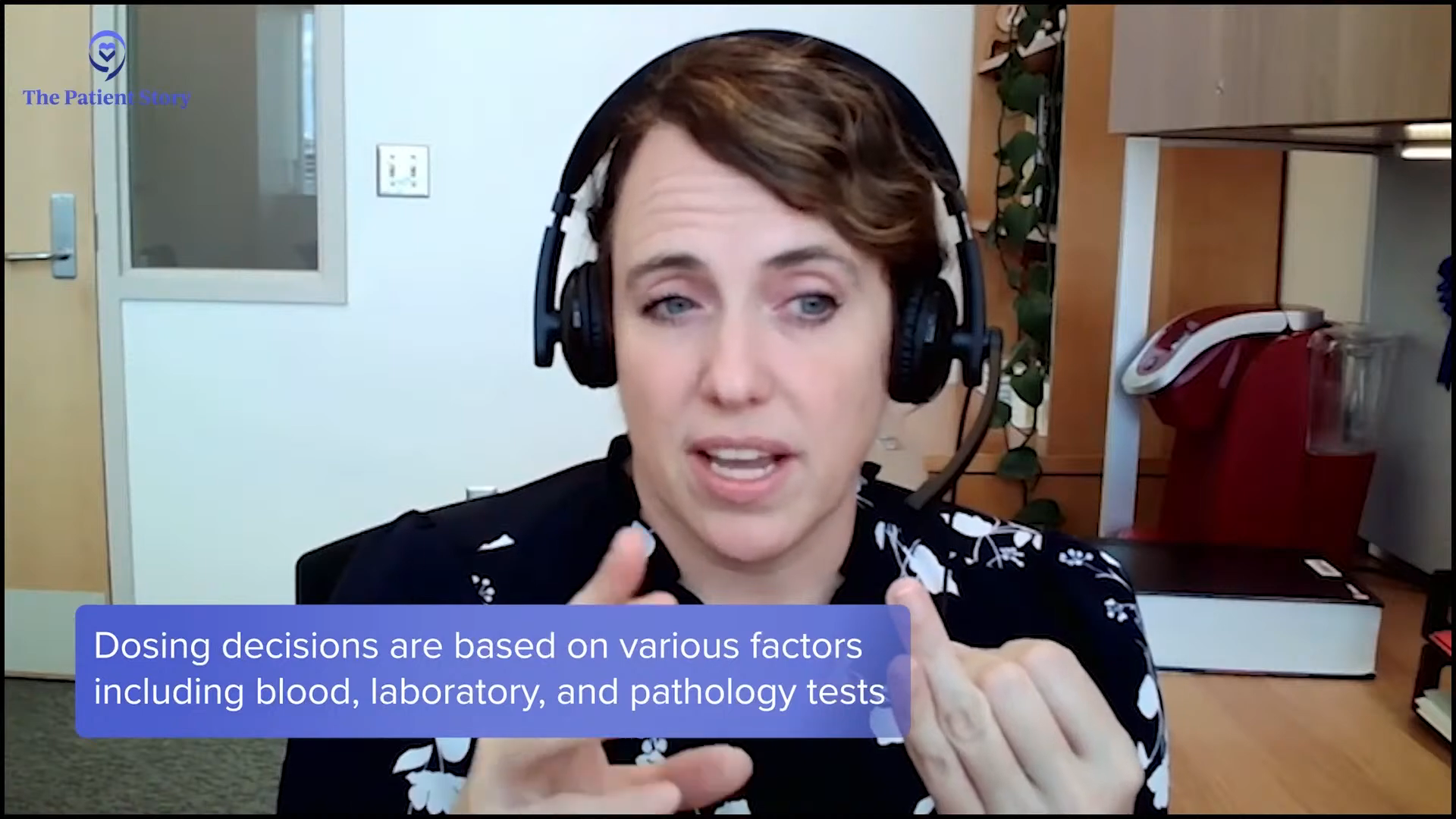
There’s a lot of room for dose reduction before you get to a point where the drug isn’t going to work. For people with side effects, maybe the target dose isn’t the right dose for them. When we do studies to design dosing of drugs, they look at drug levels in the blood, biological outcomes, and how much of that BTK protein is occupied with different dosing schedules. But that’s in a group of people and individuals can have different experiences.
There’s a lot of room for dose reduction before you get to a point where the drug isn’t going to work.
There’s some thought and some data to support this that people with side effects might naturally have different drug metabolism and maybe what’s needed is a different dose. With BTK inhibitors, there’s some scientific evidence that early in the disease, the drug is cleared by the amount of BTK in the body, which is a lot when there’s a lot of CLL, and further in is not a lot and the protein production is downregulated.
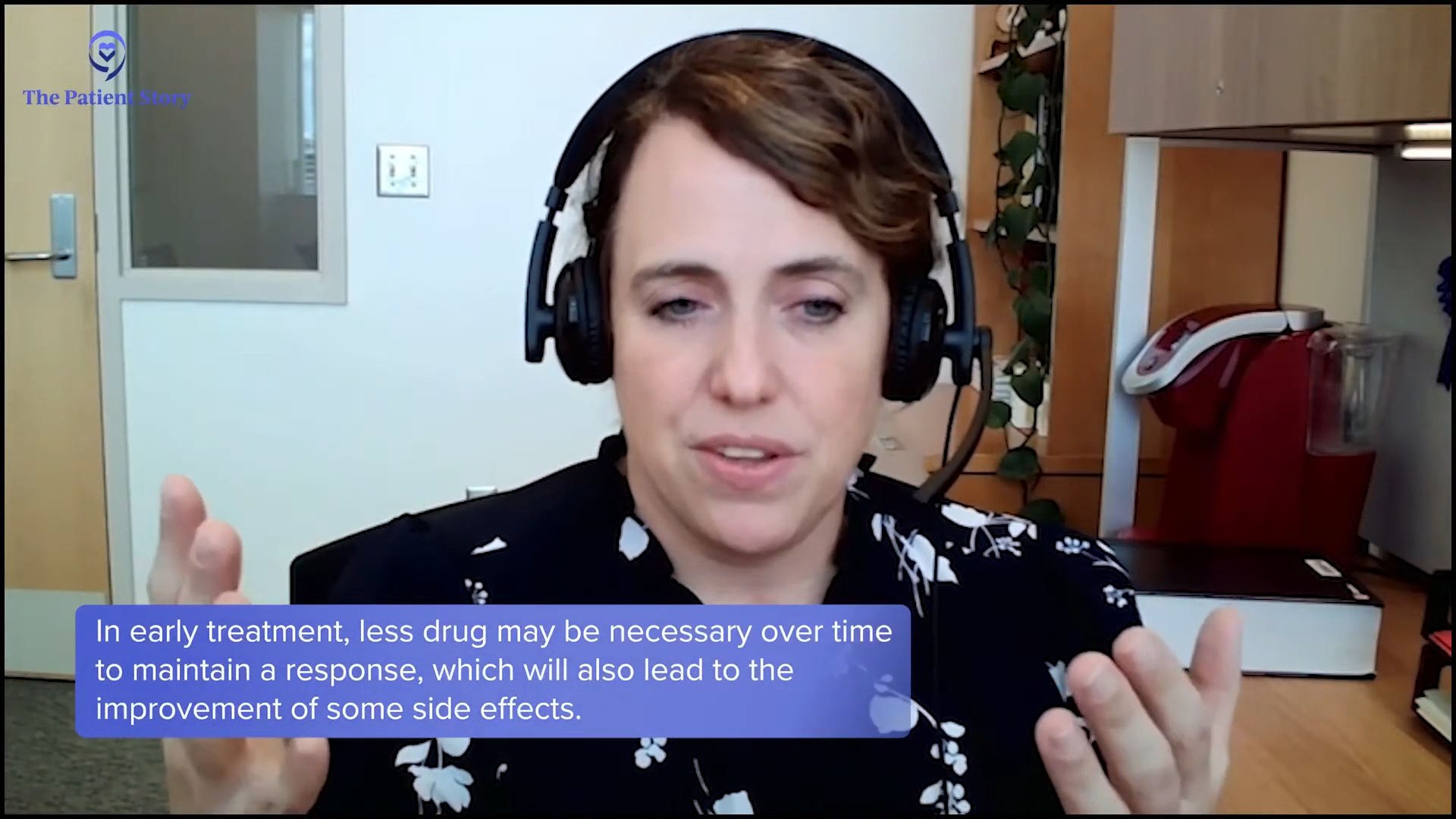
It’s quite possible that a lower dose is necessary to maintain that response after beginning treatment. Some of these side effects improve over time. People have a lot of CLL in their bodies. They see things improve every time they come for a visit. But a year in, when you’re looking at joint pain that’s interfering with your pickleball game when your blood counts look good, maybe it’s time to think about dose reduction. It’s also a time when the CLL is in a different spot and dose reduction might be more reasonable.
It’s quite possible that a lower dose is necessary to maintain that response after beginning treatment.
There are even some studies looking at databases of people using these drugs through insurance claims showing that reducing the dose did not result in a sooner time being prescribed a new treatment. It looked like it might even be going better for people probably because they were able to tolerate and stay on this drug.
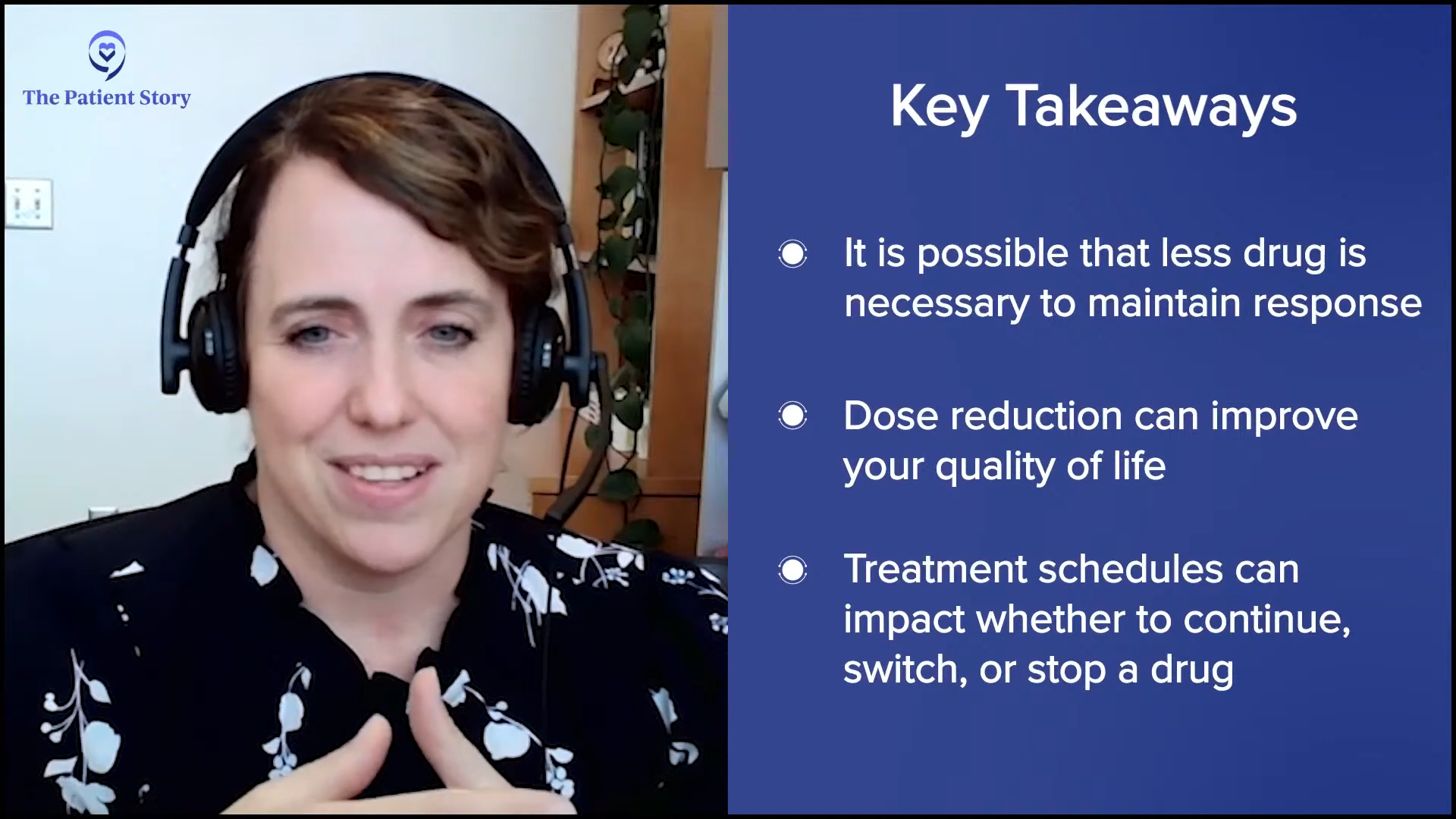
It’s always worth asking your physician anything you’re worried about. If dose reduction is suggested, talk to them about whether they expect this will change your treatment outcome, but there are plenty of reasons to think that in most cases it will not. There’s a lot of room for dose reduction in a way that we know is not going to compromise how well the treatment works.
Fostering Effective Provider Communication
Jeff: We’ve talked about side effects. We’ve talked about the difference between male and female patients and how they communicate these side effects to their care team. Is there a way that you prefer patients to communicate with you?
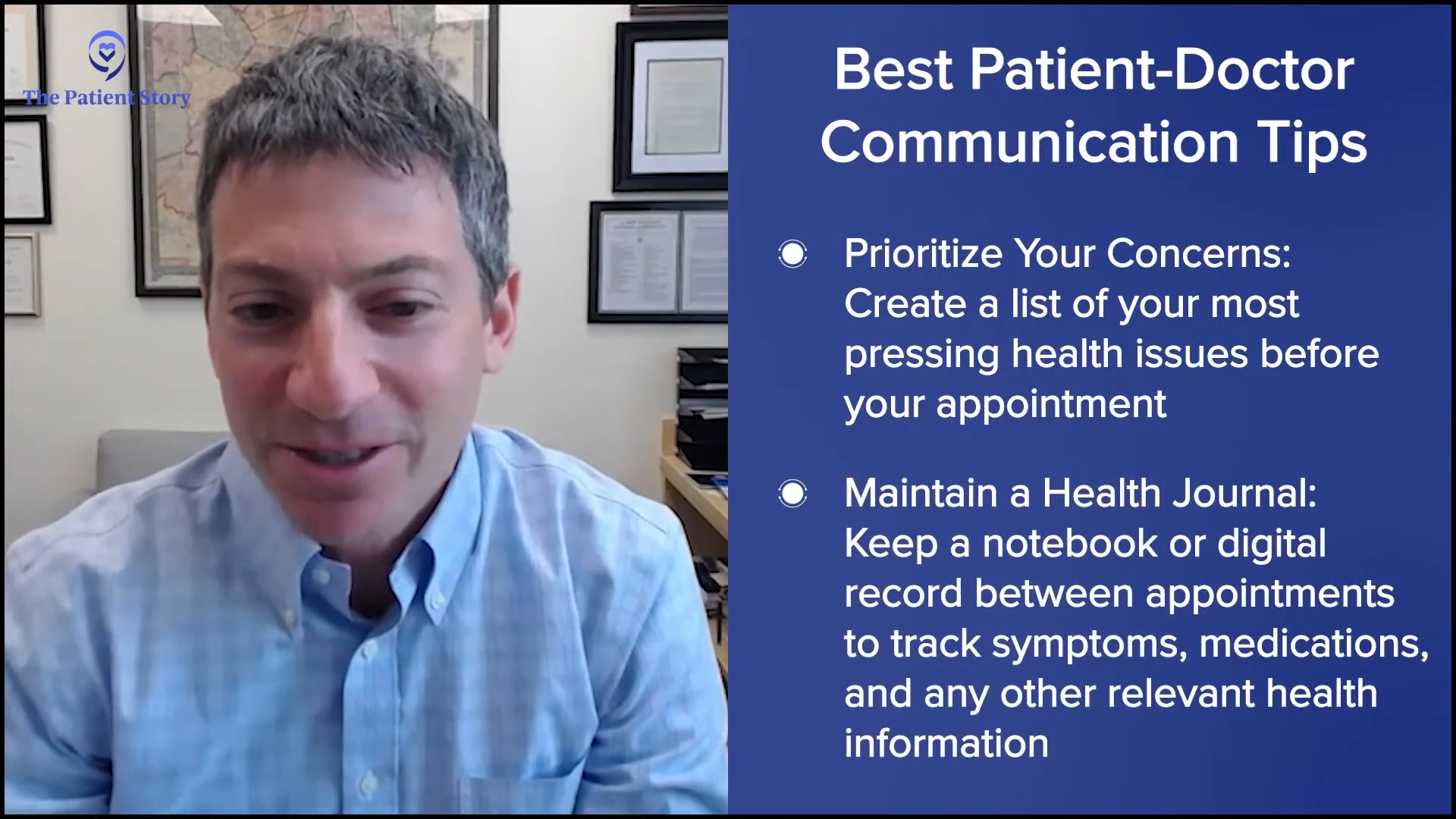
Dr. Davids: I encourage patients to make a list of their issues ahead of time before coming to the visit. When you get to a visit, sometimes you’re like a deer caught in the headlights. Sometimes people don’t think of the things that have been occurring to them.
Keep a little notebook over the months in between the visits and jot stuff down. I find it most efficient to go through all those things in person together with the patient and counsel them through each one. I don’t mind if it’s a long visit.
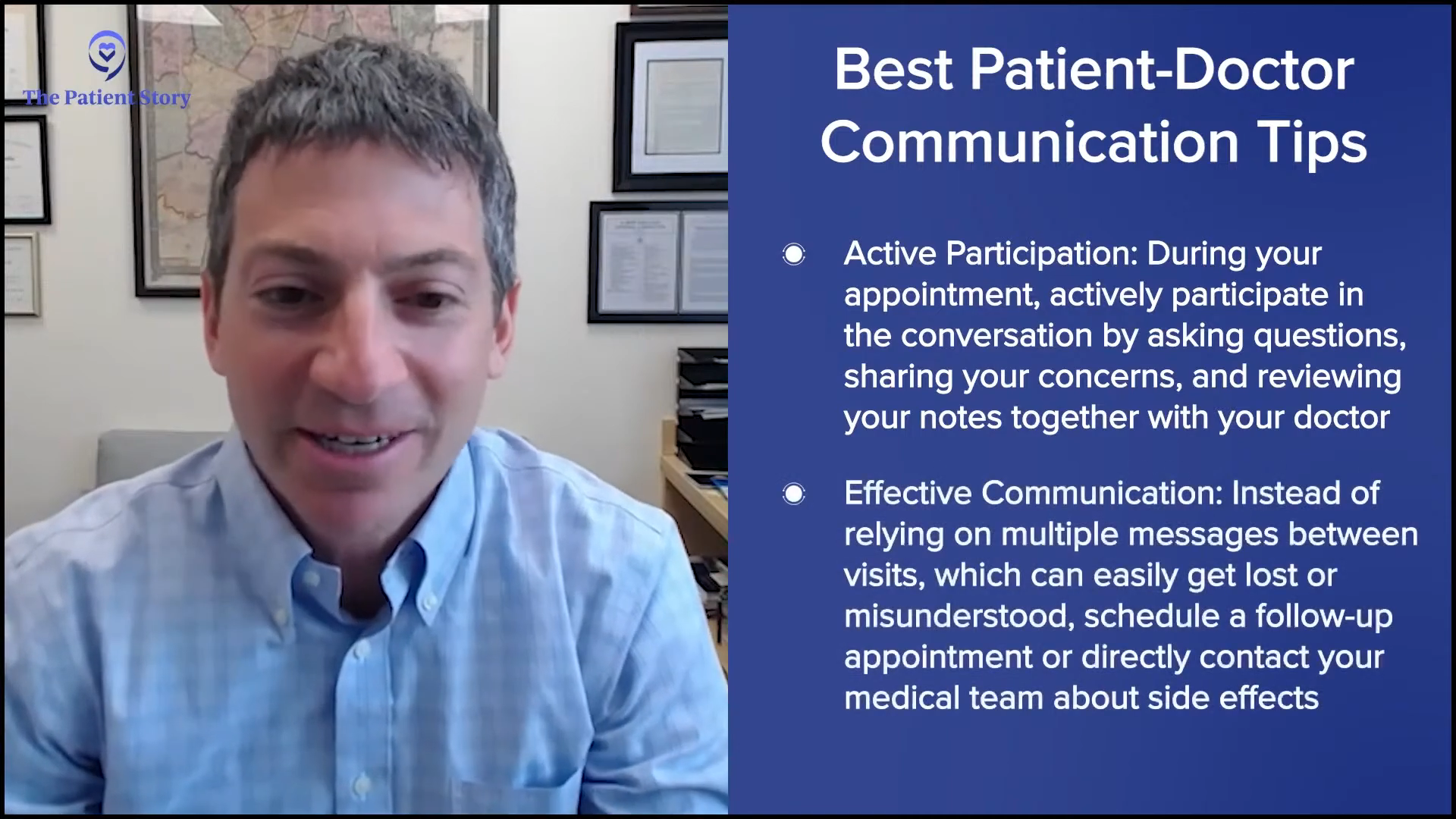
A challenging mechanism that has developed is using a patient gateway to communicate, which has its pros and cons. It’s good for patients to be able to access their care team. But sometimes, over three months, patients send a message every time they think of a question, so they may be sending 15 to 20 messages in between their three-month visits.
It takes a lot of time on our end. We try to be as responsive as we can. We’ve hired additional staff to manage the volume of messages that come in because as you can imagine, if you have 10 or 15 messages from 200 or 300 of your patients, that’s a lot. I’m not saying that’s a bad thing, but we need to rethink how we do that.
If patients are having more acute side effects, I encourage them to page us directly. We’re available to call back and have teams to help support us as well. If you’re sitting on a more serious side effect, that’s not good. Communication is key, but be smart about how to communicate.
A challenging mechanism that has developed is using a patient gateway to communicate, which has its pros and cons.
Dr. Rogers: If there are things you want to discuss, make a list. I’ve had a couple of people who send a list of questions a week before their appointment through the patient portal. We have a list now so that they know what it is and I can read what it is. Some people take physical notes, some people have them on their phones. If there’s something that they want to discuss, decide ahead and use your visit time to do it.
The patient portal is an excellent communication tool, but you can’t be doing that every day, asking something new. We do those during business hours. I tell my patients that they’re welcome to write a note at 2 a.m., but we will not be replying until the next business day. Sometimes, you get people who send a bunch of concerns and I tell them that we can’t answer all of these on the phone and that we’re going to schedule a visit. Occasionally, we’ll provide education. This is a concern. This is something that should be handled by the phone, so we can call and get it sorted out.
I have some patients who don’t use MyChart and they have a different way to communicate with us. It’s good to have multiple approaches. In terms of making lists of questions and sending them ahead, whatever helps you stay organized so that you get the answers you need.
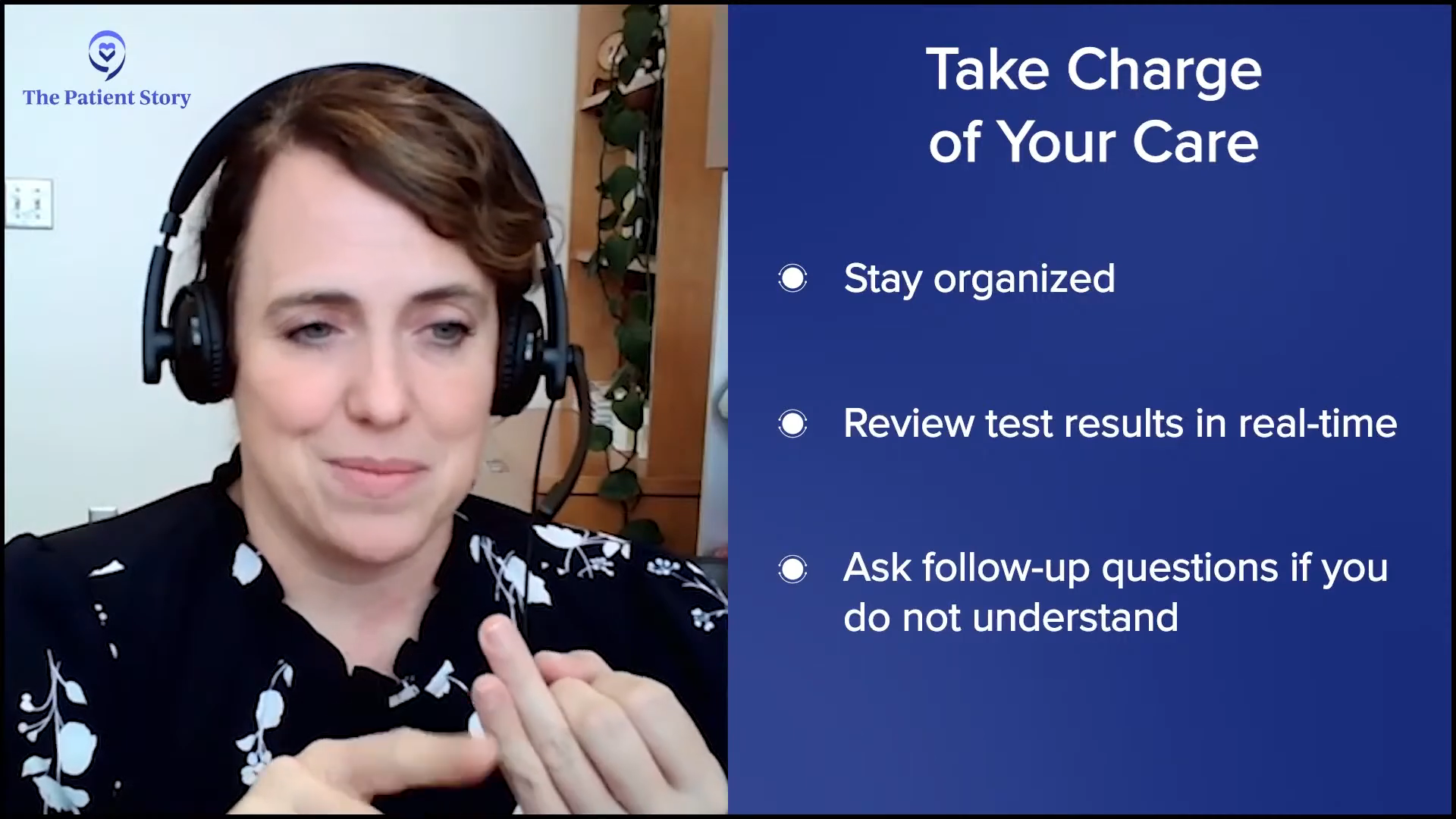
Something that has been very helpful for us is open notes. We have been required to provide all test results to patients and provide notes. Some people like reading them but some people don’t. Some patients couldn’t remember something I said so they went back and looked at what I wrote and that helped. They didn’t have to call because they saw my notes. Some people know how to look at those. Some people don’t. They’re not written in patient-friendly language.
Patients will get their blood test results before they even come to see me, so they can think of questions about their results and I can address that during the visit.
Think through if you want to open your test results on a weekend and do what’s right for you.
Overall, it’s good to allow people access to their health information immediately. But I’ve had a few patients who call us up very angry that we released imaging results on a weekend. We didn’t do that; radiology did. Then they thought they had no way to reach out to us about something they were terrified about, which is also not true.
We have a 24-hour answering service if people are extremely worried about a test result that was released to them by the system on a weekend. Understand the process and the value in it but also think through if you want to open your test results on a weekend and do what’s right for you.
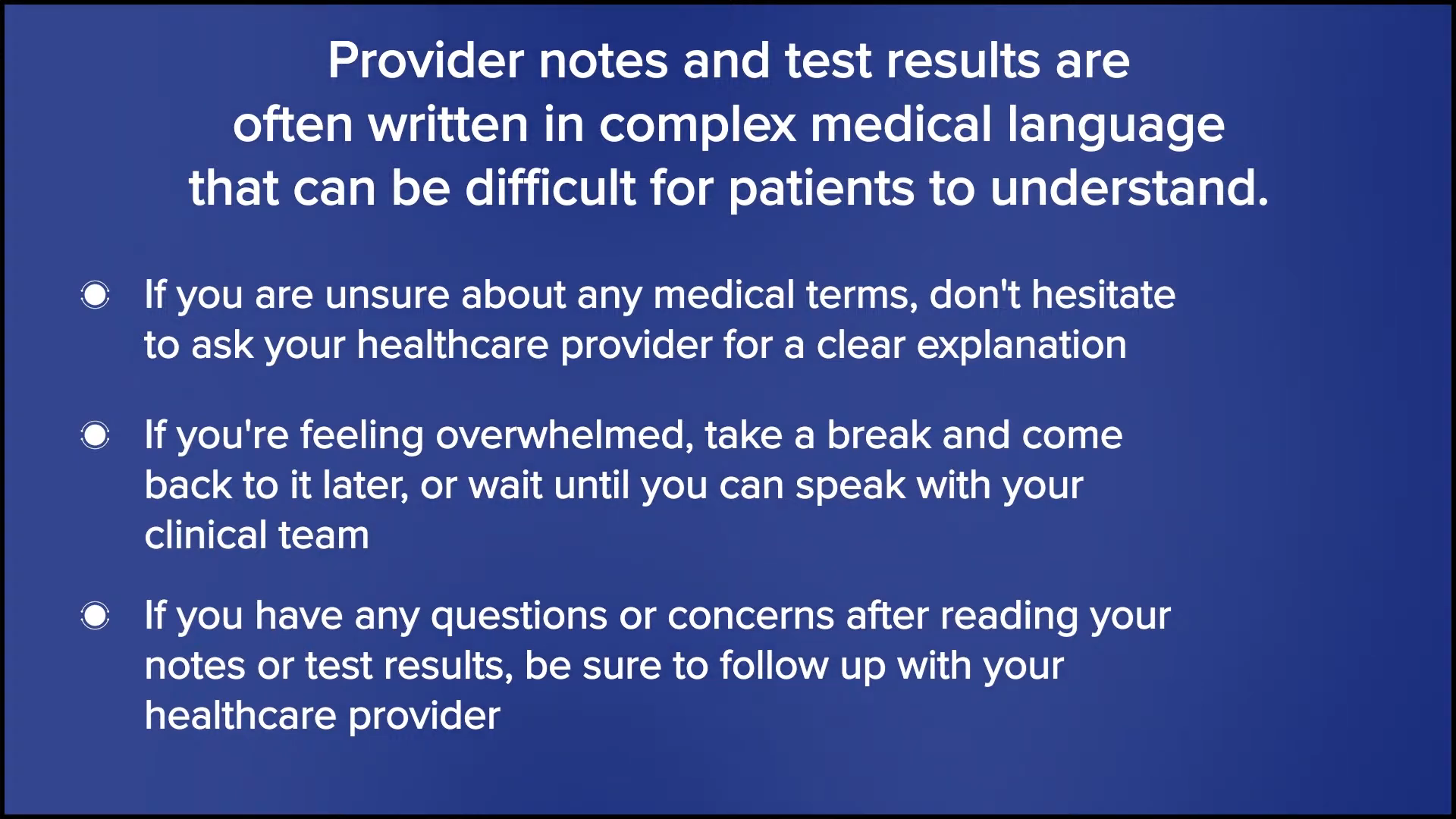
Dr. Davids: I feel very similarly about test results. It’s great to have access to all your data, but you have to know yourself. If you’re the type of person who’s going to freak out if you see something strange in a report and it’s a Friday evening and no one’s going to be able to get back to you for a few days, don’t open the report.
I see our job as looking at those reports, filtering out the things that aren’t worrisome, and telling you what’s important. Patients will be very worried about a tiny little lung nodule that wasn’t described before. If it’s 2 mm, I’ll say that they don’t have to worry about it, but if you see that result first and I’m not immediately available, you may be worried for days. It doesn’t bother some people and if you’re one of them, look right away. You have to know yourself and what you’re comfortable with.
If you’re the type of person who’s going to freak out if you see something strange in a report… don’t open the report.
Dr. Rogers: We have a system where if it’s a result that needs emergent action, which rarely happens in my clinic, the radiologist will call me so I can contact the patient. We don’t release test results with emergent findings without anyone on the healthcare team being notified, which I think some people don’t know.
Jeff: For the past couple of years, as I sat in the waiting room after having my blood work done, I have a very distinctive alert from my phone as my test results start coming in. I’m one of those people who are face down on the phone almost instantly because I want to know what questions to ask my doctor when I go in to review those results.
I’m coming up on 15 years of living with CLL and I’ve learned that the most important thing is not one test result; it’s the trend of the test results and how things are going over time. Not everyone is there yet and this is part of how we communicate with our care providers. This is how we work with our team.
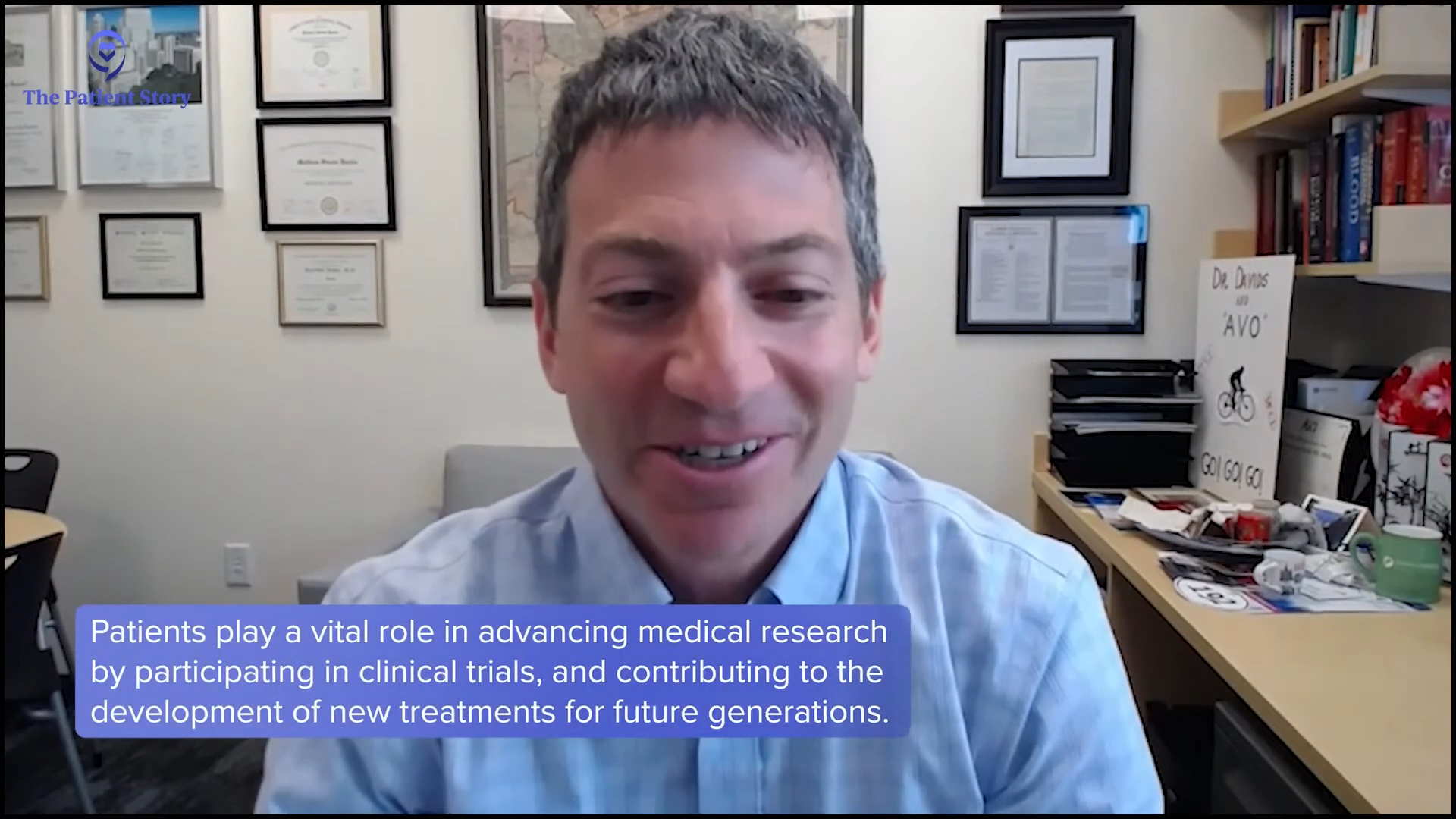
Clinical Trials in CLL
Jeff: We’ve been talking about BTK inhibitors and it seems like the drugs keep on coming, one after the other after the other. When I started, it was pretty much FCR (fludarabine, cyclophosphamide, and rituximab) or nothing.
Let’s talk about how we got here. We’ve been doing all this research. We have CLL patients participating in clinical trials. We have the data coming back. How do you anticipate these advancements and how they’re going to impact treatment decisions? Are people going to put off starting treatment because something new is right around the corner?
Dr. Davids: We wouldn’t have all these great new drugs if patients didn’t go on clinical trials. The patients who came before helped bring these drugs to the patients of today. Patients of today also should consider clinical trials because you can help to develop the next wave of drugs for the next wave of patients. Patients deserve a ton of credit for making all this possible.
We wouldn’t have all these great new drugs if patients didn’t go on clinical trials.
Ibrutinib was a huge advancement. When I heard about a new BTK inhibitor coming along, acalabrutinib, I was skeptical at first. We already have a great drug with ibrutinib. Why do we need a second BTK inhibitor? Acalabrutinib turned out to be as equally effective as ibrutinib but with fewer side effects. It was a big innovation that acalabrutinib came along.
Then zanubrutinib came along and I said the same thing. Why do we need another, more selective BTK inhibitor? It turned out that in one study, zanubrutinib is better than ibrutinib in terms of how well it controls the CLL and is better tolerated.
Pirtobrutinib works very differently from the three BTK inhibitors and it can work even after all three of those other drugs stop working, so that’s a big advance. I’ve been proven wrong at each step along the way.
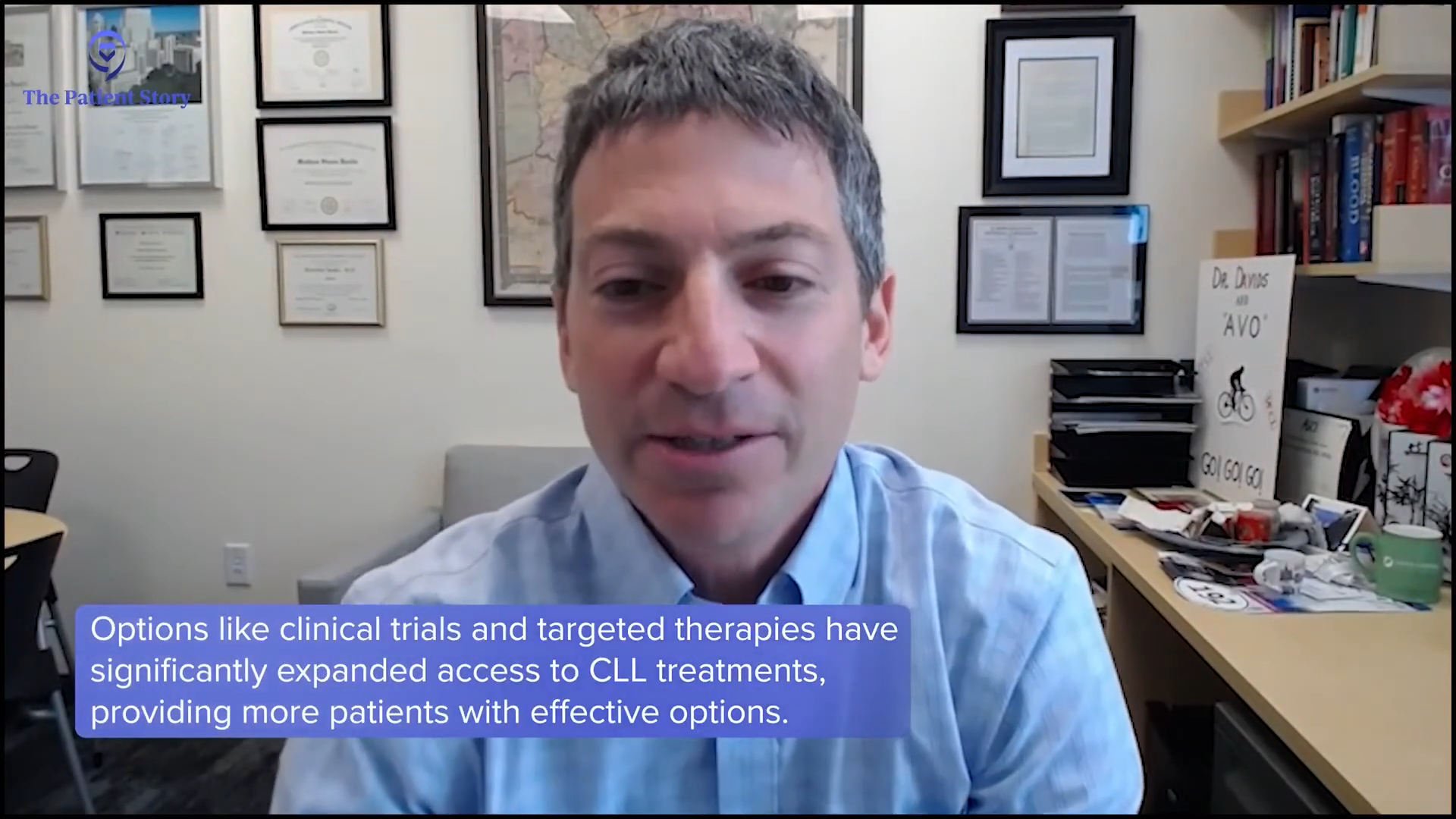
It’s helpful to have four different BTK inhibitors. I’m trying not to make the same mistake with a new class of drugs called BTK degraders, which are in early-phase clinical trials. This is another way to target BTK and they’re showing some significant promise.
It’s possible and very likely that eventually, we’ll have at least a fifth BTK inhibitor approved for this disease. It’s not what we’d call me-too drugs where it’s the same drug with a different label. These are all different drugs. They all have pros and cons and there’s a role for each of them in the treatment of CLL. It’s exciting times and continues to be exciting for patients to have all these options continuing to evolve.
It takes some courage to try new combinations or schemes for giving them.
Dr. Rogers: I completely agree. The only reason that we have these drugs is because people were willing to participate in clinical trials. I also see people who are afraid of participating in a clinical trial for fear of getting a placebo. Some of the lack of understanding of what research participation is a barrier to people doing it. It takes a lot of courage to do something where we don’t have all the information about how this particular treatment scheme is going to work.
A study we have right now for people going through their first treatment is a combination of currently approved drugs. Mostly, when people hear what it is, they say, “Okay, neat. These are drugs that you’re talking about as a standard of care.” It takes some courage to try new combinations or schemes for giving them. I always try to remember to cover that people will not be getting a placebo because we don’t have that in any of our current CLL trials.
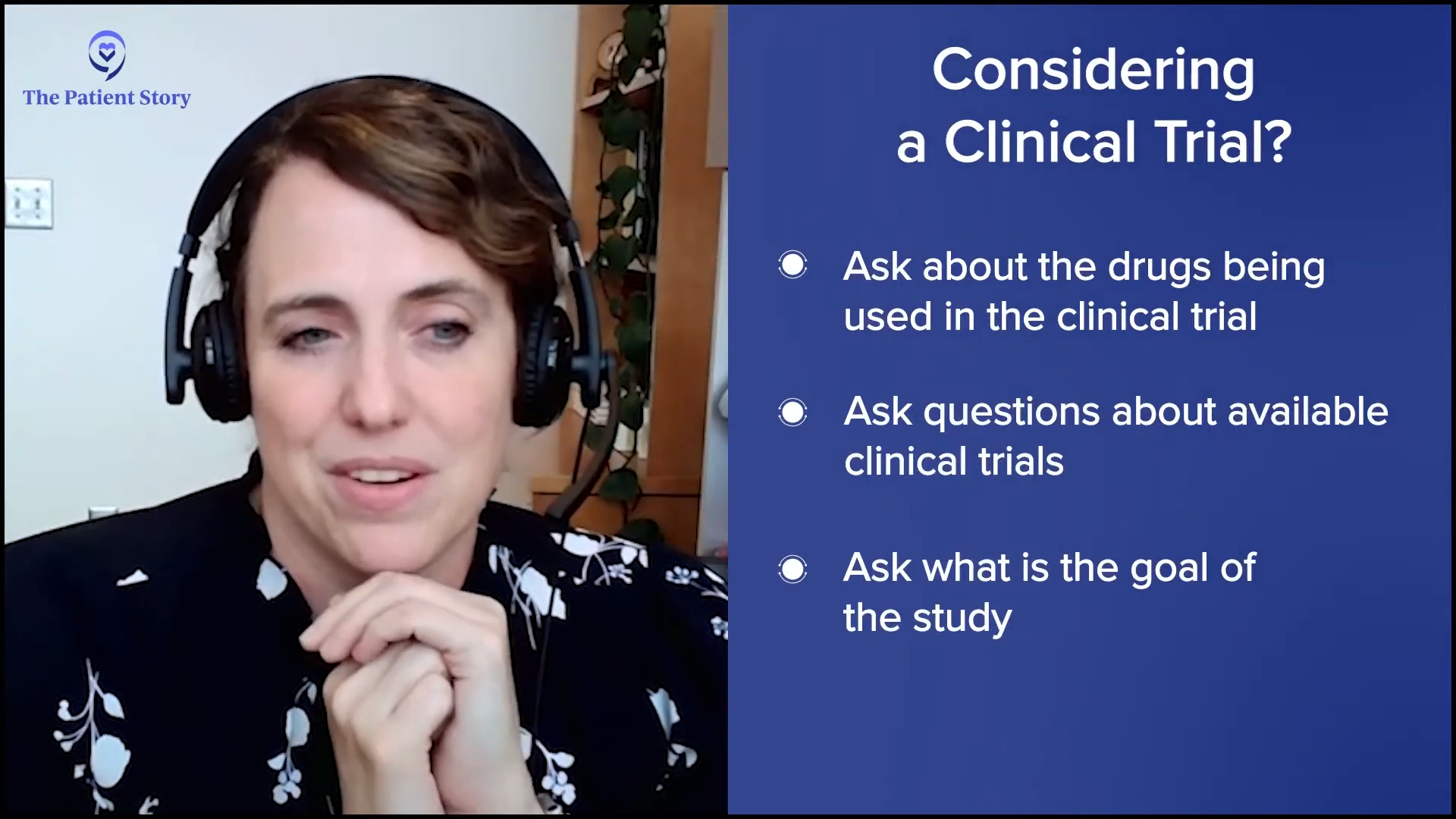
Someone said once that participating in a clinical trial is like getting tomorrow’s treatment today. For people who are worried or don’t want to take an investigational drug, I remind them that these currently approved drugs were drugs that people got as research participants before they were on the market. They were able to benefit from what is a highly effective therapy before it was commercially available. This can directly improve the type of treatment people are getting, even though there’s some element of unknown because it’s a research study and we’re trying to learn more about these drugs.
For anyone considering research participation, definitely asking what’s known about the drug, where it is in development, and what the goal of this study is can help people understand better. When people are excited about approved drugs, we were able to treat people with those same drugs before they were commercially available because they participated in research.
These currently approved drugs were drugs that people got as research participants before they were on the market.
I would never suggest a clinical trial that I didn’t think was going to be highly beneficial to the person who was going to take that treatment. We’ve talked about choices for taking a first targeted agent, but there are people who have had CLL that’s now become resistant to several targeted agents. That’s where drugs we have under investigation are much more likely to be effective for their CLL than drugs that are currently on the market and a huge reason for people to consider research participation. At that point, you’re going to get something that we know is very likely to be better than commercially available drugs.
Shared Decision-Making in Your Care
Jeff: What you were saying got me thinking about this process as a collaborative process. It used to be like it or not. The paradigm was a patient presented with an illness, they saw the doctor, the doctor did an evaluation, the doctor prescribed a course of treatment, and the patient took the treatment. Things have changed now.
We have a lot of options. There are four BTK inhibitors. There’s venetoclax. There are monoclonal antibodies. There’s no treatment. I would like to think that we’re moving closer to a collaborative environment where the care team does the decision matrix with the patient. Dr. Rogers, how do you foster that environment with the patient?
We’ll discuss the treatments and by the time we’re done talking, it’ll be clear what to do and we can decide together.
Dr. Rogers: I strive to make my clinic a collaborative environment. When the venetoclax and obinutuzumab regimen was approved, you have BTK inhibitors versus venetoclax and obinutuzumab. I had a lot of consultations with people considering their options for the first treatment and asking me what they should do. Until I get to know you, I can’t help you. I can’t tell you what to do.
Usually, I say, “Why don’t we talk? I have some questions for you. You probably have some questions for me. We’ll discuss the treatments and by the time we’re done talking, it’ll be clear what to do and we can decide together.” That’s the best approach.
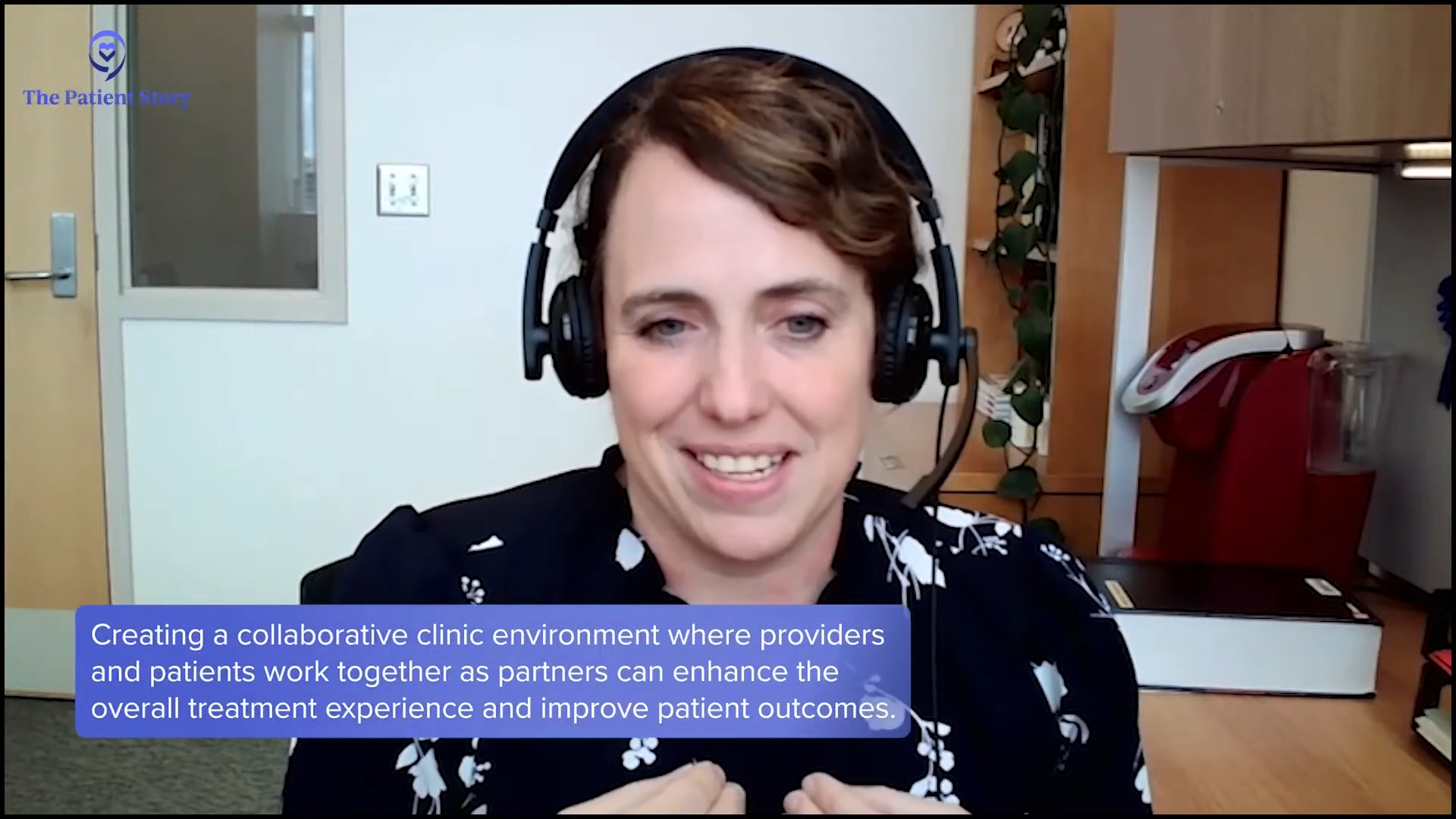
Some people don’t want to get options. They’re very overwhelmed by the options, so they want a recommendation. After a discussion, they say, “I don’t want to think about this. Ask me what you need to know to make the best recommendation for me, but I don’t want options. I want you to tell me what I should do.”
I find it difficult to pick for someone. I have to ask enough questions so that I can make the recommendation for what I think will be best. I respect the fact that some people get overwhelmed by the choices, don’t want to have options, and want to be told what to do. That’s not the way I prefer to do things, but if that’s what the person who I’m taking care of wants, then I try to do that.
I try to narrow it down. Often, there will be 1 or 2 options that I would prefer for the patient.
Dr. Davids: I have a very similar approach, I would say. Some patients prefer to be told what to do and it’s important to ask what their preference is upfront about how they want to approach it.
Another scenario is completely leaving it up to the patient. Present the options as all being equal and let the patient choose. I tend not to do that so much either, so I try to narrow it down. Often, there will be 1 or 2 options that I would prefer for the patient.
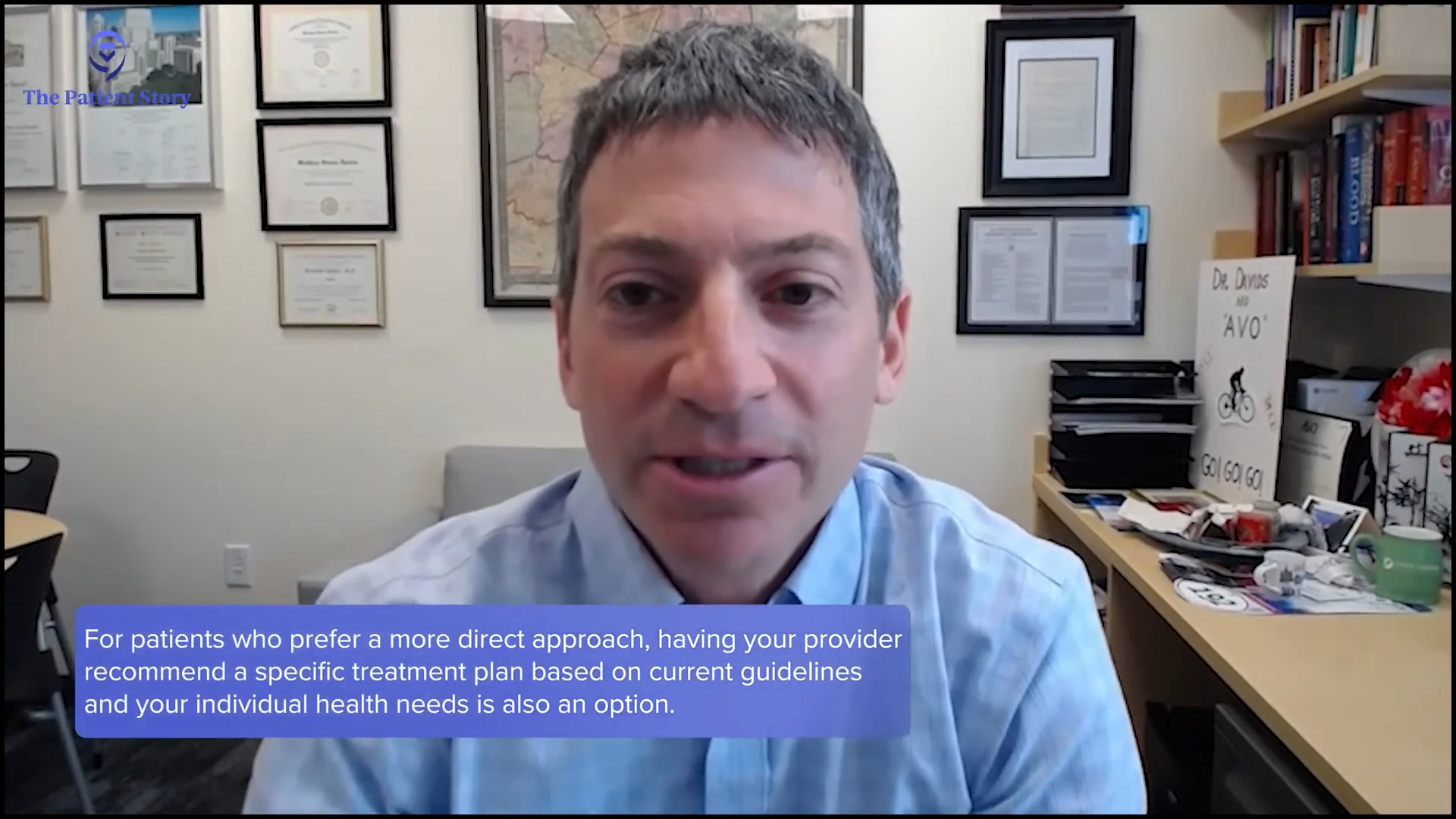
Sometimes you get the dreaded question: what would you do if this was your sister or your mother? I would recommend to a patient anything that I would for a family member because I believe in it no matter who I’m recommending it for.
There are scenarios where we’ve gotten down to maybe two or three options and the patient will say, “I would lean more toward this one based on what you’ve told me, but these other choices are reasonable too, so think it over.” Ultimately, it’s the patient’s choice. I see my role as guiding them to that choice and sometimes it does help if I express what my thought is for a particular patient. A lot of patients find that helpful.
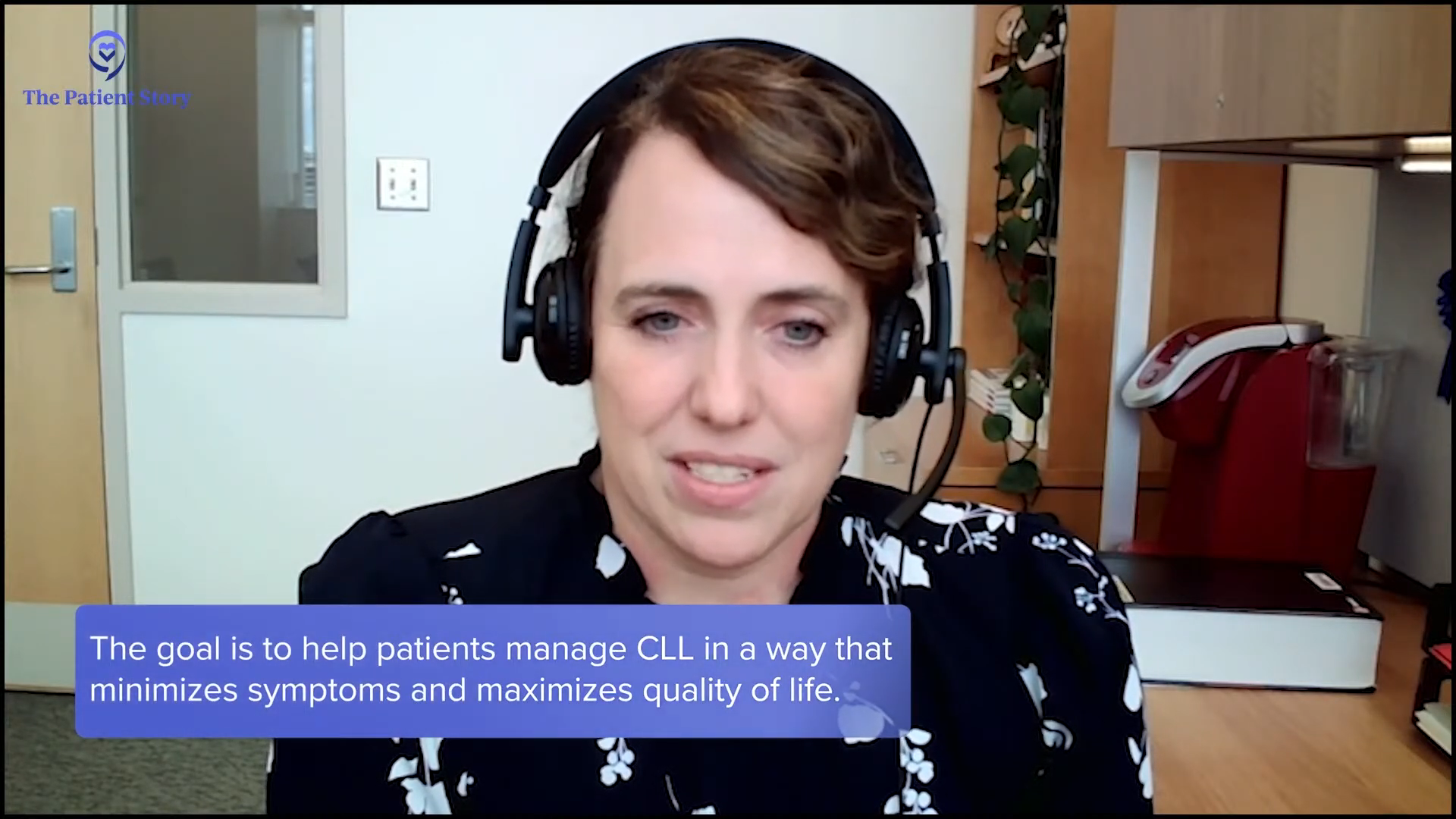
Final Takeaways
Jeff: If a brand new CLL patient comes into your clinic and you’ve got 60 seconds to give them one message, what do you tell them?
Dr. Rogers: I usually tell people that we expect them to live with this for a very long time. The goal is to help them live as well as possible and be the least bothered as possible by CLL.
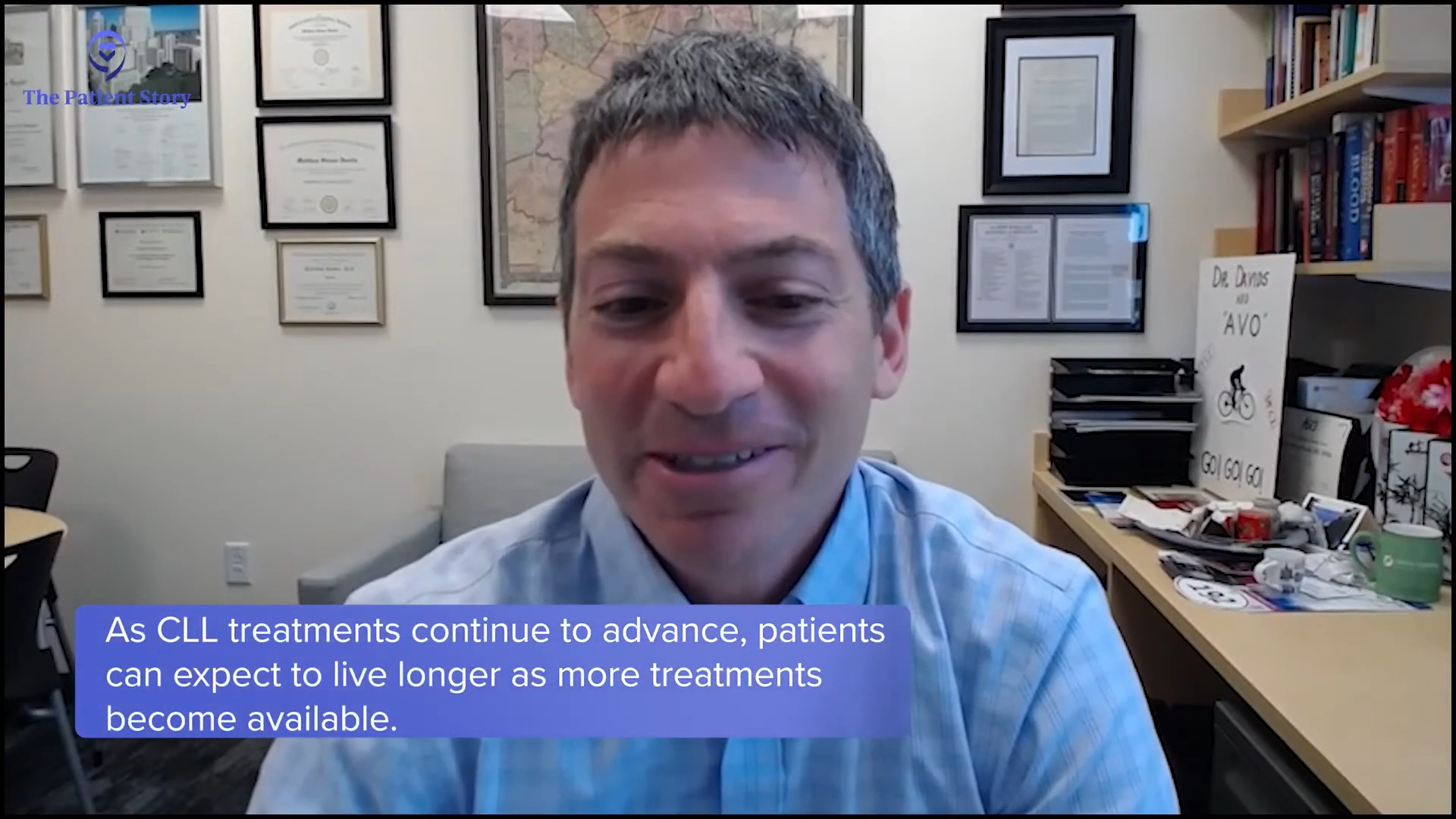
Dr. Davids: Depending on their age, for patients diagnosed with CLL in their 70s and 80s, I always say to them that our goal is to have them live whatever their normal life expectancy would be otherwise. We have very effective treatments and it’s unlikely that CLL is going to shorten your lifespan.
For younger patients, I don’t feel as confident saying that yet because if you’re diagnosed with CLL in your 50s, we don’t know what happens with these targeted therapies 30 years from now. I tell those patients that we already have a lot of good treatments, but over the next few years, we expect even more good treatments to be developed. The longer you live with CLL, the longer you’re going to live with CLL because we’ll have more and more treatments available. I also try to be optimistic.
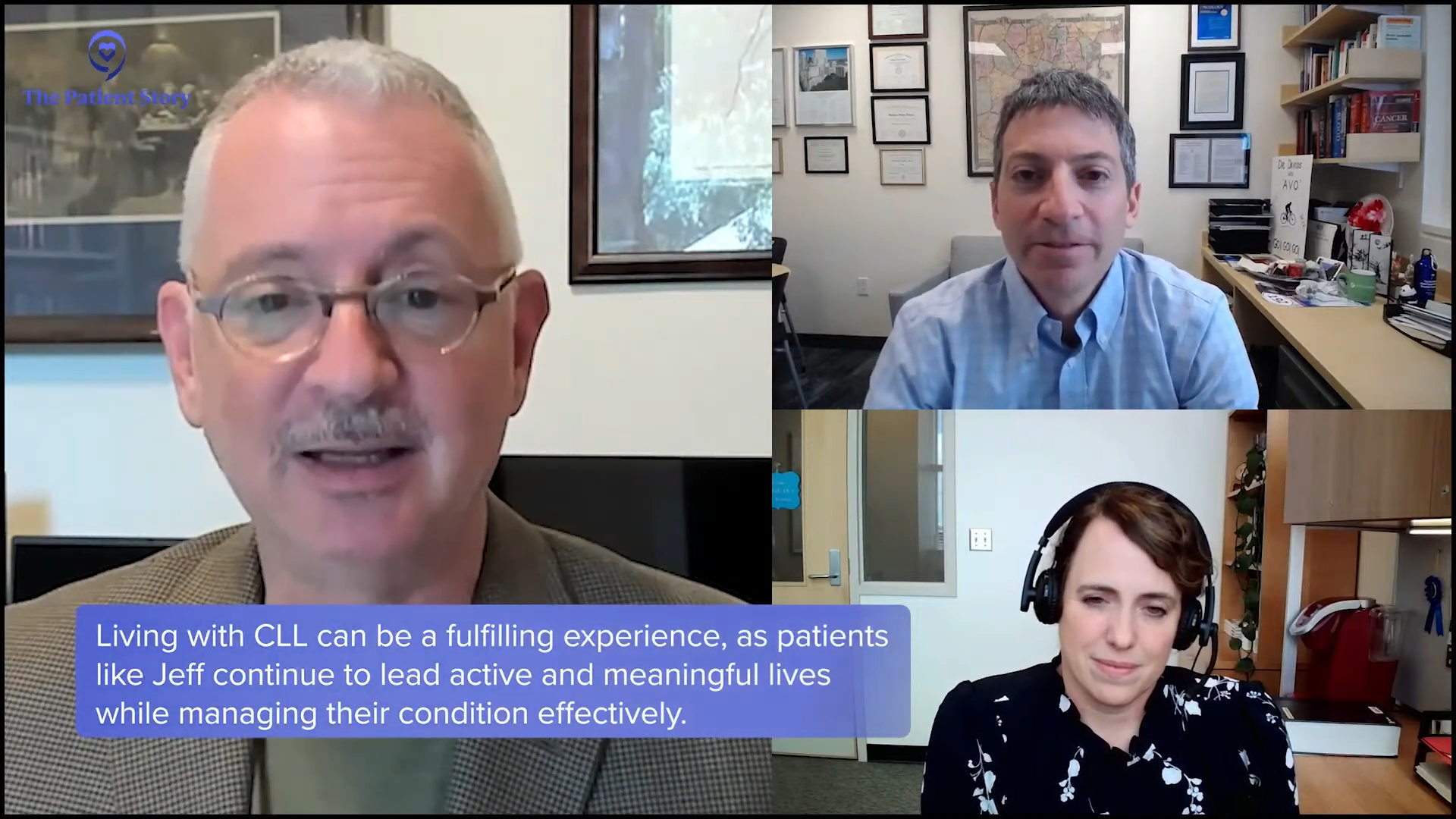
Jeff: I was diagnosed with CLL at 46 and I’m now 60. Currently, I’m knocking out between 40 and 55 miles every week speed walking. I’m eating well and drinking well. I’m being a good father and husband. I’m doing all the things that I would want to do if I didn’t have CLL. I’m living a good life. It’s my mission as a patient advocate to make sure that it is possible to live a very good life, even with a CLL diagnosis.
I take an active role in my care. I listen to my care team when they say I need to do this, this, and this. I do what I need to do to present my body to my care team in the best possible shape so that when it is time to treat, we get to pick the right treatment plan so that I can live my best life. That is literally what I want for every single patient and caregiver. You can live a very long, very good life with CLL.
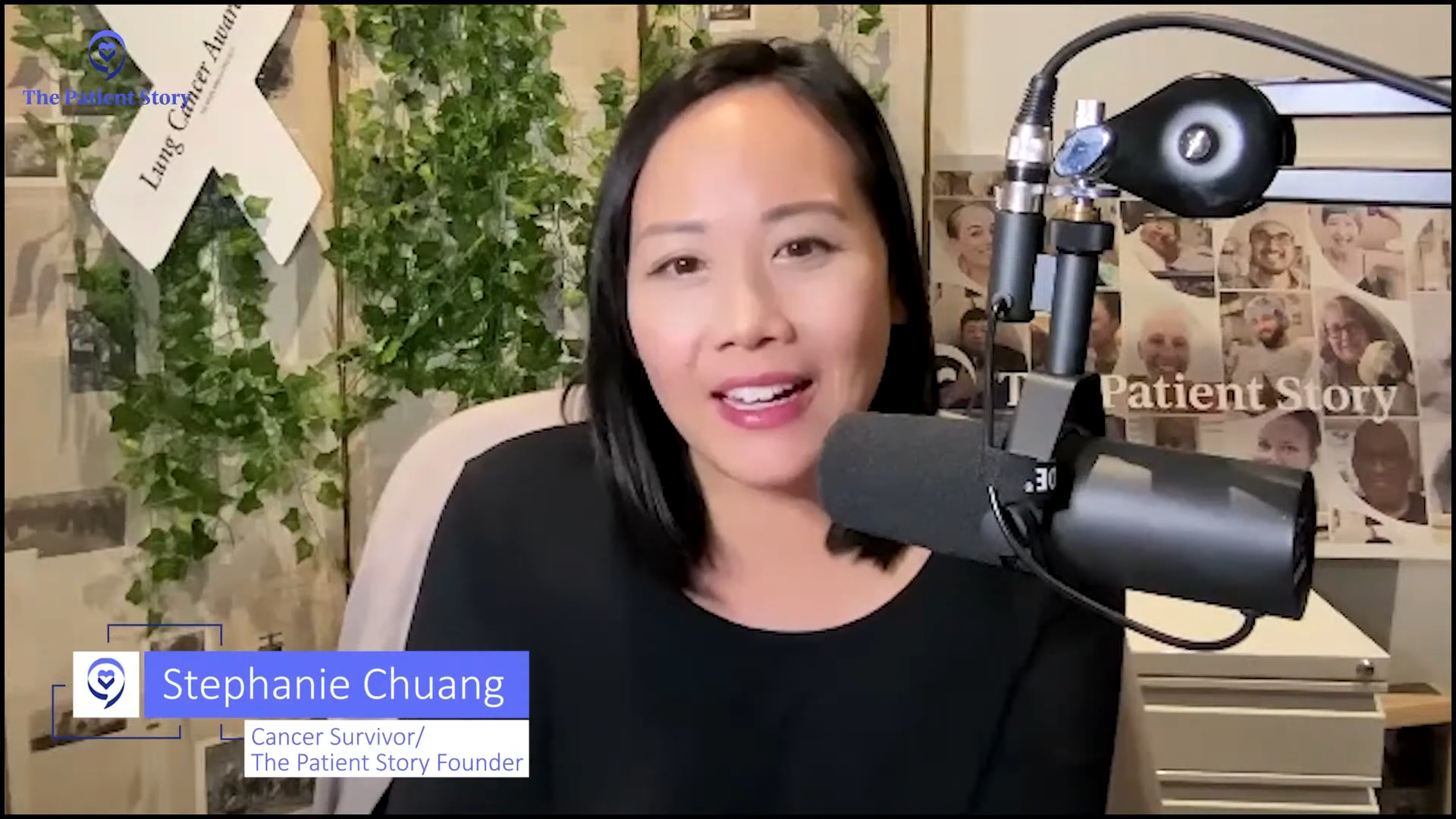
Conclusion
Stephanie: Thank you so much, Jeff, for your guidance in the conversation and for your perspective. We always want to make sure that we are emphasizing what that patient and care partner voice is. It is critical obviously beyond the education here.
Thank you so much, Dr. Rogers and Dr. Davids, for not only being incredible as CLL specialists but also for providing so much more time and extra time to help the community beyond the people and the patients you see in the clinic.
We also want to say thanks again to our sponsors for their support of our independent patient program and special thanks also to our partners, The Leukemia & Lymphoma Society and The CLL Support Group.
Thank you so much for joining us. I hope that this was helpful in one way or another. We hope to see you in a future program. Take good care.


Thank you to The Leukemia & Lymphoma Society and The CLL Support Group for their partnerships.
CLL Patient Stories
Lynn S., Chronic Lymphocytic Leukemia (CLL)
Symptom: Elevated white blood cell count
Treatments: Chemotherapy, targeted therapy (BTK inhibitor)
Serena V., Chronic Lymphocytic Leukemia (CLL)
Symptoms: Night sweats, extreme fatigue, severe leg cramps, ovarian cramps, appearance of knots on body, hormonal acne
Treatment: Surgery (lymphadenectomy)
Margie H., Chronic Lymphocytic Leukemia
Symptoms: Large lymph node in her neck, fatigue as the disease progressed
Treatment: Targeted therapy
Nicole B., Chronic Lymphocytic Leukemia
Symptoms: Extreme fatigue, night sweats, lumps on neck, rash, shortness of breath
Treatments: BCL-2 inhibitor, monoclonal antibody
